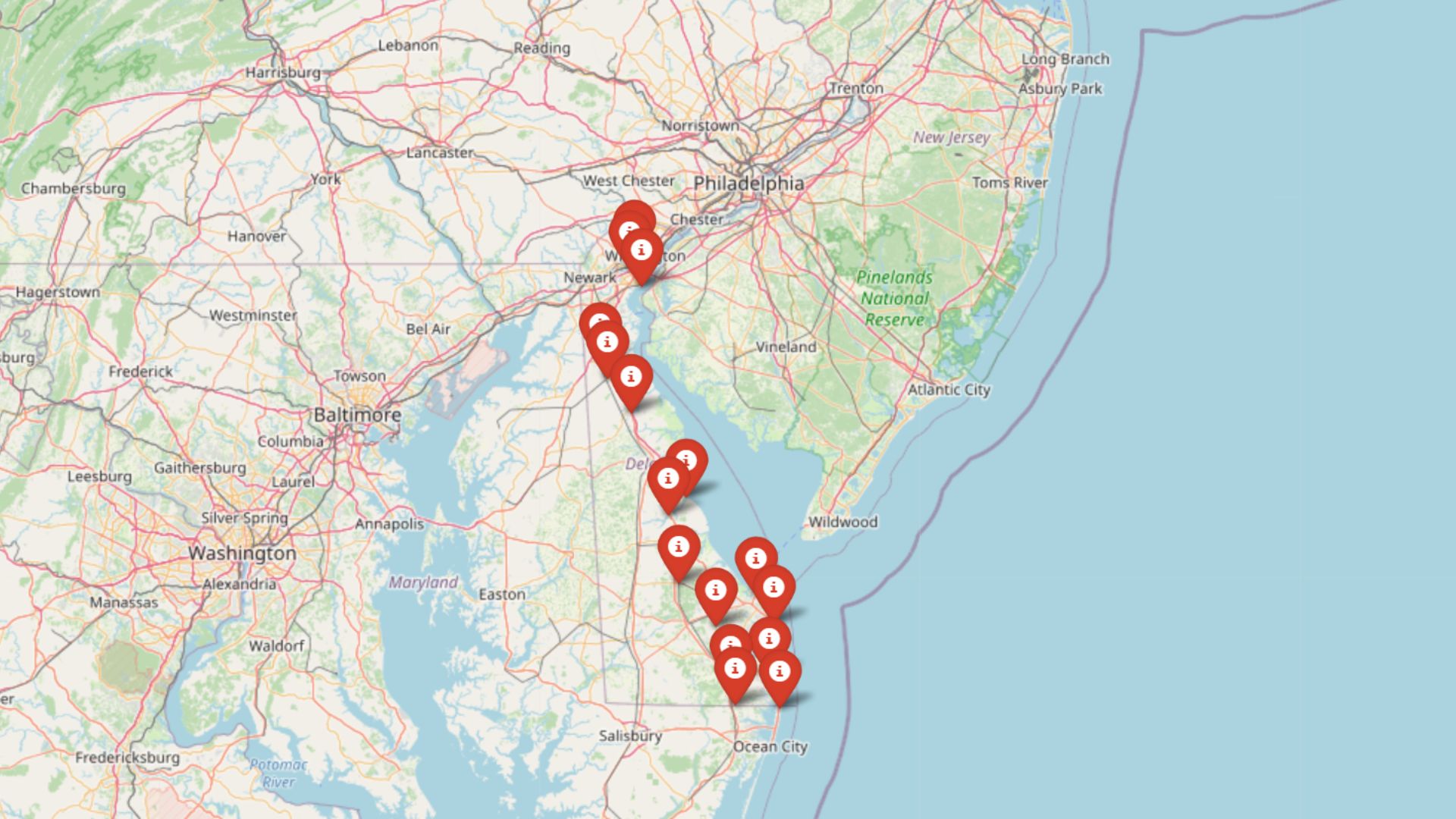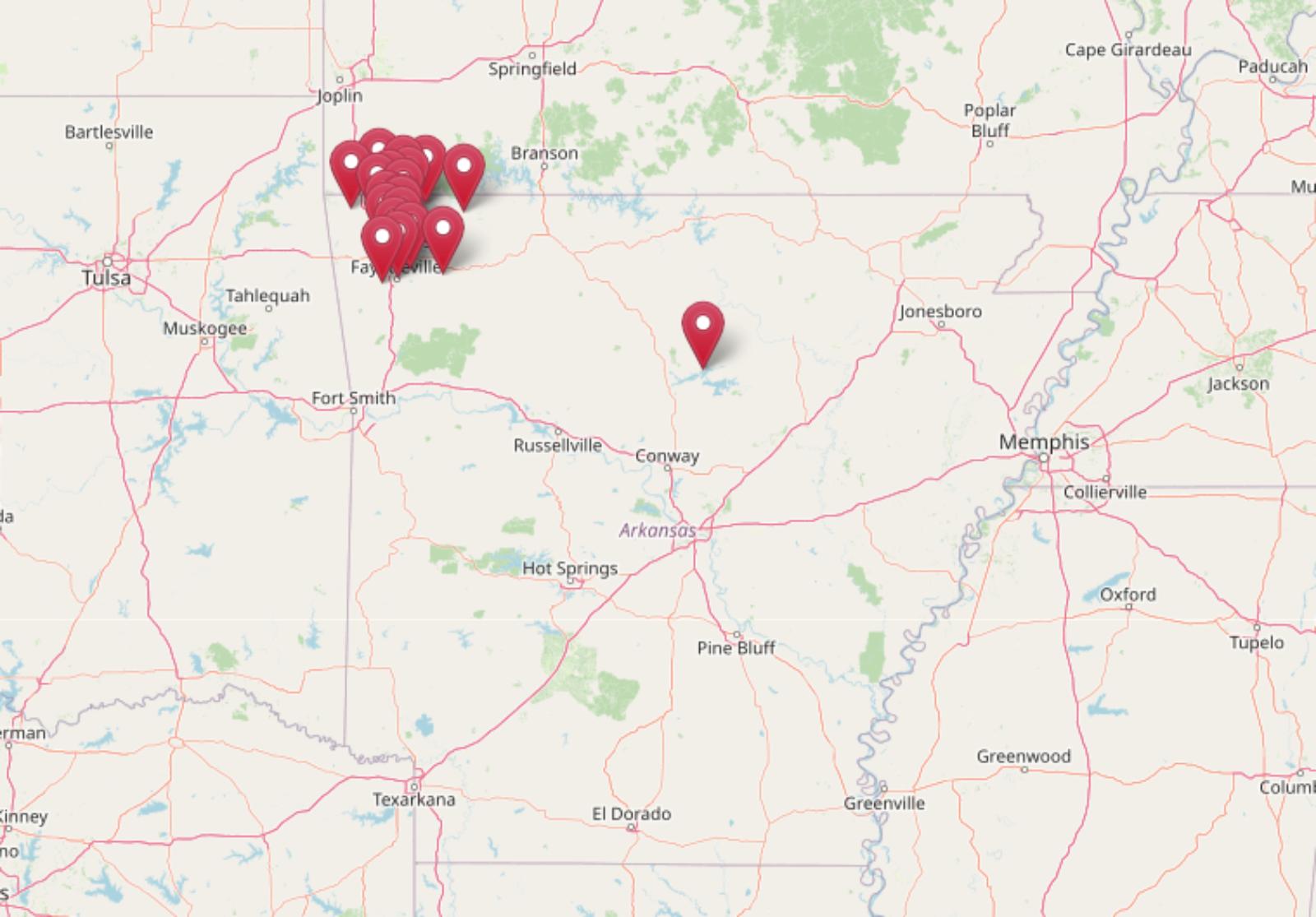
Arkansas might have a reputation for affordable living, but not everywhere fits that narrative in 2025. According to the Zillow Home Value Index, some towns are seeing home prices climb well past what buyers expect in this typically budget-friendly state. From booming Northwest Arkansas communities to scenic Ozark enclaves, rising demand has driven up prices in both new hotspots and long-established markets. Whether it’s job growth, lifestyle appeal, or simple supply-and-demand, these towns are where Arkansas property values are breaking records.
20. Eureka Springs – 95.77% Home Price Increase Since 2010
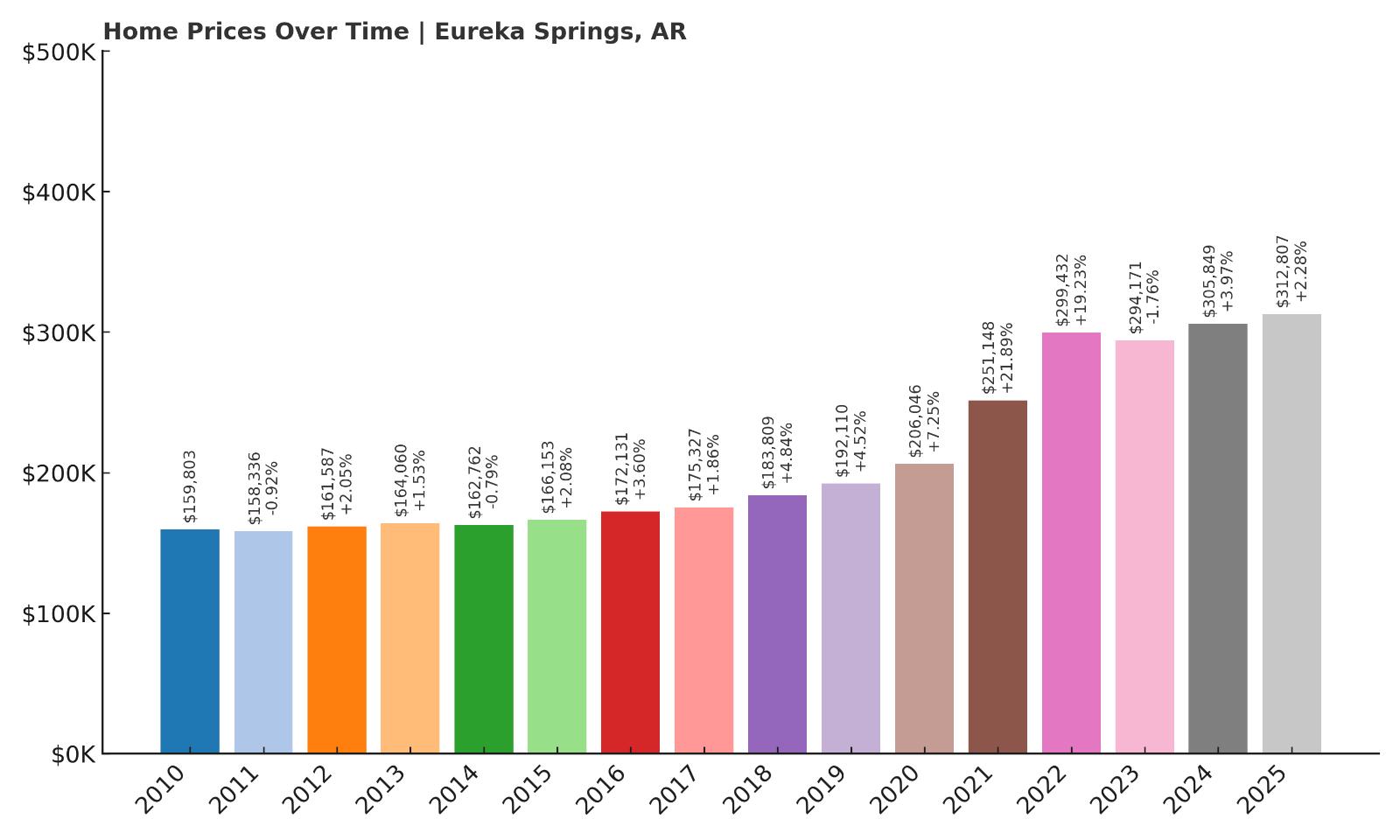
- 2010: $159,803.91
- 2011: $158,336.81 ($-1,467.10, -0.92% from previous year)
- 2012: $161,587.11 (+$3,250.30, +2.05% from previous year)
- 2013: $164,060.90 (+$2,473.79, +1.53% from previous year)
- 2014: $162,762.37 ($-1,298.53, -0.79% from previous year)
- 2015: $166,153.47 (+$3,391.10, +2.08% from previous year)
- 2016: $172,131.45 (+$5,977.98, +3.60% from previous year)
- 2017: $175,327.64 (+$3,196.19, +1.86% from previous year)
- 2018: $183,809.32 (+$8,481.68, +4.84% from previous year)
- 2019: $192,110.51 (+$8,301.19, +4.52% from previous year)
- 2020: $206,046.08 (+$13,935.57, +7.25% from previous year)
- 2021: $251,148.63 (+$45,102.55, +21.89% from previous year)
- 2022: $299,432.22 (+$48,283.59, +19.23% from previous year)
- 2023: $294,171.51 ($-5,260.71, -1.76% from previous year)
- 2024: $305,849.32 (+$11,677.81, +3.97% from previous year)
- 2025: $312,807.63 (+$6,958.31, +2.28% from previous year)
Home prices in Eureka Springs have climbed nearly 96% since 2010, rising from just under $160,000 to over $312,000 in 2025. While annual growth was modest for most of the 2010s, things changed dramatically starting in 2020. The town experienced a massive surge in 2021 and 2022, with back-to-back double-digit gains that added nearly $100,000 in value over two years. There was a slight dip in 2023, but the market rebounded in 2024 and continued upward in 2025. Overall, the price trend shows a shift from gradual appreciation to rapid acceleration in the post-pandemic years. These numbers point to growing demand in a town that’s long been admired for its charm and tourism appeal. For buyers, that means Eureka Springs has become one of Arkansas’s most expensive places to purchase a home—even compared to larger cities.
Eureka Springs – Tourism, History, and Rising Real Estate Appeal

Nestled in the Ozark Mountains near the Missouri border, Eureka Springs has long attracted visitors with its Victorian architecture, hilly terrain, and thriving arts scene. The town’s downtown area is listed on the National Register of Historic Places, and its layout—built into winding mountain streets—gives it a character few places can match. This uniqueness, combined with strong tourism, makes it a desirable location not just for visitors, but also for buyers seeking second homes or vacation rentals. While limited land availability restricts new development, that scarcity contributes to higher home values. The recent price increases reflect this tight inventory combined with national migration trends favoring scenic, small-town environments.
Eureka Springs is not a typical commuter town—it thrives as a destination in itself. Residents enjoy a calendar full of festivals, nearby hiking and biking trails, and an eclectic mix of independent restaurants and shops. The appeal to out-of-state buyers, especially during the pandemic housing boom, drove up competition in a market that’s never had much volume to begin with. Even with the slight dip in 2023, long-term value remains strong, and the consistent recovery through 2024–2025 shows continued resilience. For investors and lifestyle buyers alike, Eureka Springs offers both character and long-term upside—though that charm now comes at a premium.
19. Edgemont – 64.08% Home Price Increase Since 2010
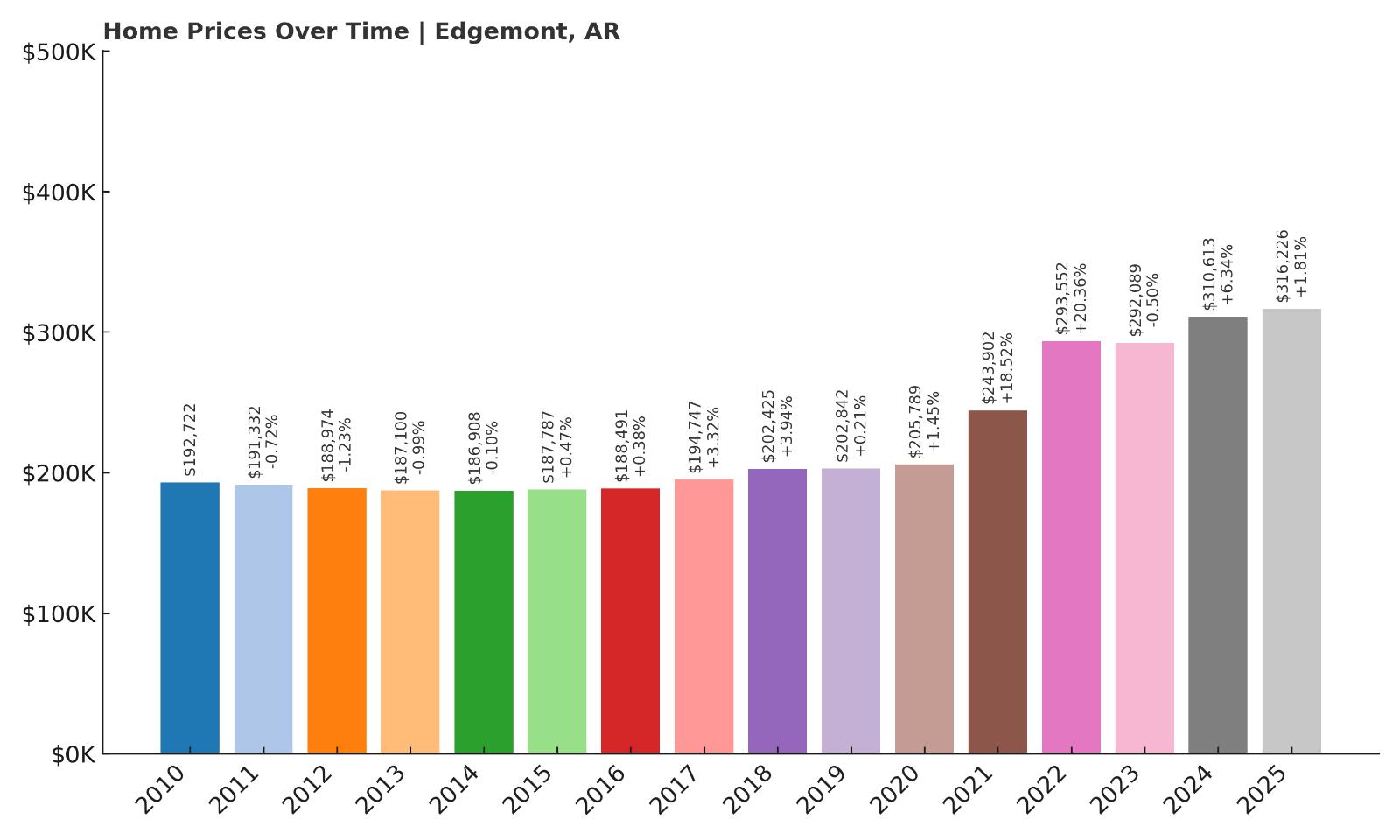
- 2010: $192,722.92
- 2011: $191,332.17 ($-1,390.75, -0.72% from previous year)
- 2012: $188,974.33 ($-2,357.84, -1.23% from previous year)
- 2013: $187,100.85 ($-1,873.48, -0.99% from previous year)
- 2014: $186,908.36 ($-192.49, -0.10% from previous year)
- 2015: $187,787.72 (+$879.36, +0.47% from previous year)
- 2016: $188,491.96 (+$704.24, +0.38% from previous year)
- 2017: $194,747.38 (+$6,255.42, +3.32% from previous year)
- 2018: $202,425.15 (+$7,677.77, +3.94% from previous year)
- 2019: $202,842.66 (+$417.51, +0.21% from previous year)
- 2020: $205,789.51 (+$2,946.85, +1.45% from previous year)
- 2021: $243,902.94 (+$38,113.43, +18.52% from previous year)
- 2022: $293,552.21 (+$49,649.27, +20.36% from previous year)
- 2023: $292,089.41 ($-1,462.80, -0.50% from previous year)
- 2024: $310,613.23 (+$18,523.82, +6.34% from previous year)
- 2025: $316,226.28 (+$5,613.05, +1.81% from previous year)
Edgemont’s home values rose by 64% from 2010 to 2025, with most of the gains happening in just the last few years. For nearly a decade, prices hovered around the $190,000 range with only slight annual fluctuations. But in 2021, the market turned sharply upward, adding nearly $100,000 in just two years. Although there was a minor dip in 2023, the market resumed growth afterward. This recent surge has pushed Edgemont into Arkansas’s top 20 most expensive towns for the first time. It’s a major shift from the flat trends of the early 2010s and signals a town coming into focus for more buyers. The combination of affordability, lake access, and improved infrastructure likely played a role in the recent growth wave.
Edgemont – Quiet Lake Living With Surging Demand
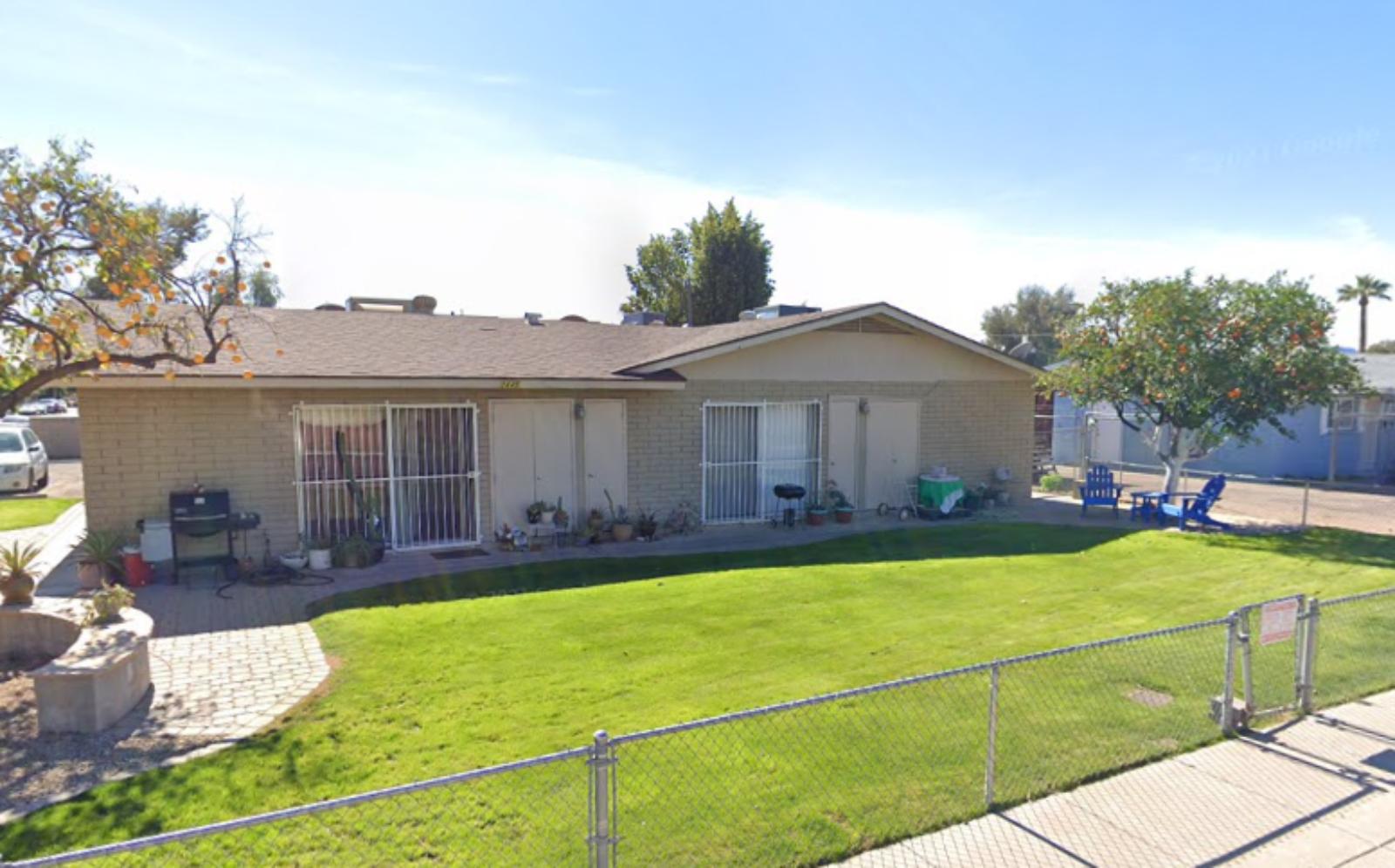
Edgemont is a small, unincorporated community near Greers Ferry Lake in Cleburne County. Known for its peaceful setting and access to outdoor recreation, it’s long been popular with retirees and second-home buyers looking for waterfront living without the price tags of bigger resort towns. Boating, fishing, and vacation rentals are all part of the local lifestyle. However, until recently, that demand didn’t show up strongly in pricing. The jump that started in 2021 suggests that interest from out-of-state buyers or lifestyle movers post-pandemic brought new attention to the area. As nearby urban centers get pricier, towns like Edgemont start to look like smart alternatives.
Because much of Edgemont consists of spread-out lake homes and cabins, inventory is typically limited—and that plays a big role in keeping prices high. There’s also relatively little new construction, which means values are driven mostly by demand for existing properties. Many buyers are looking for quiet, scenic environments within weekend reach of cities like Little Rock, and Edgemont delivers on that promise. The real estate market here isn’t especially volatile, but the upward trend in the last few years reflects larger shifts in buyer behavior statewide. With prices now topping $316,000, Edgemont is no longer just a quiet retreat—it’s a high-value property market on its own terms.
18. Farmington – 117.67% Home Price Increase Since 2010
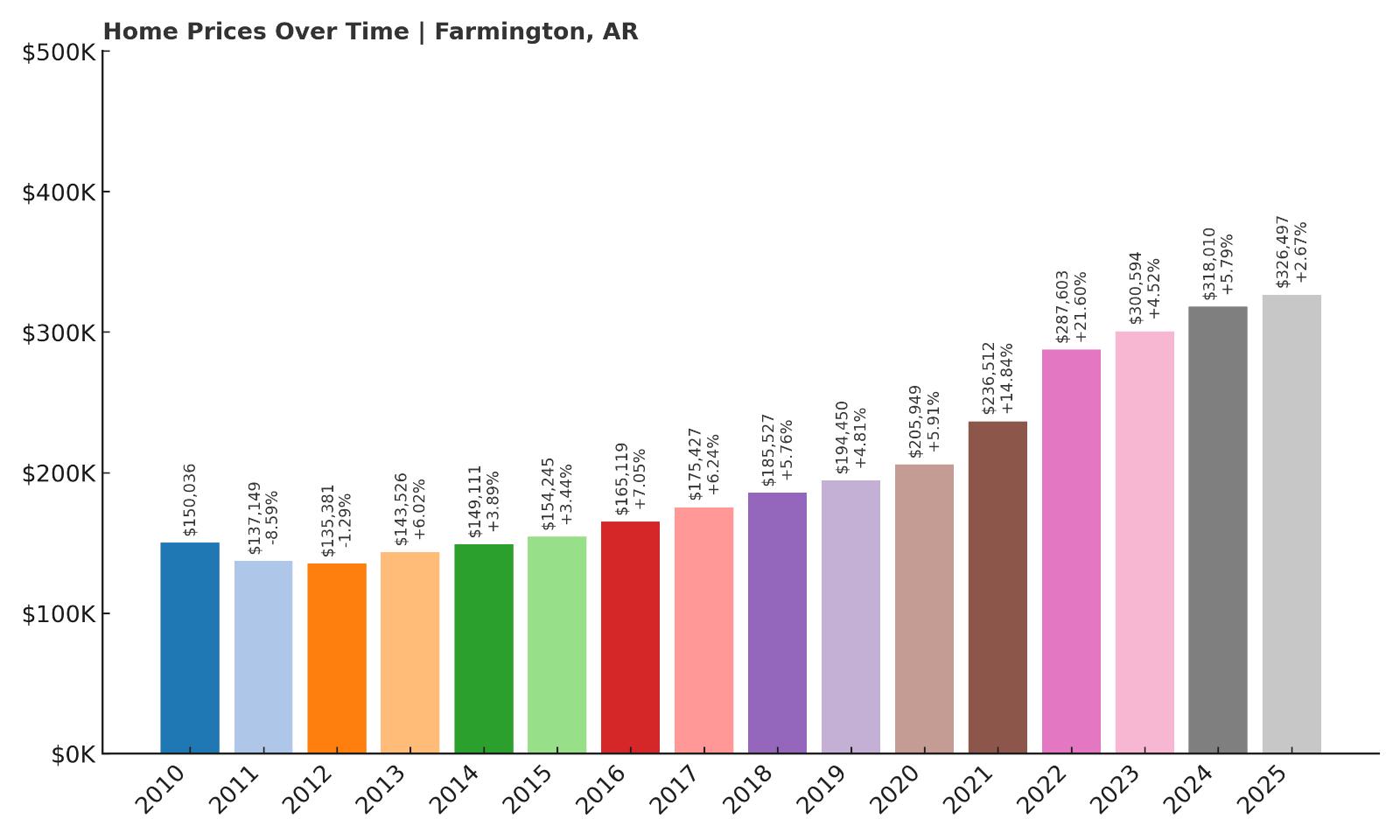
- 2010: $150,036.81
- 2011: $137,149.06 ($-12,887.75, -8.59% from previous year)
- 2012: $135,381.09 ($-1,767.97, -1.29% from previous year)
- 2013: $143,526.81 (+$8,145.72, +6.02% from previous year)
- 2014: $149,111.25 (+$5,584.44, +3.89% from previous year)
- 2015: $154,245.14 (+$5,133.89, +3.44% from previous year)
- 2016: $165,119.52 (+$10,874.38, +7.05% from previous year)
- 2017: $175,427.24 (+$10,307.72, +6.24% from previous year)
- 2018: $185,527.17 (+$10,099.93, +5.76% from previous year)
- 2019: $194,450.77 (+$8,923.60, +4.81% from previous year)
- 2020: $205,949.25 (+$11,498.48, +5.91% from previous year)
- 2021: $236,512.93 (+$30,563.68, +14.84% from previous year)
- 2022: $287,603.72 (+$51,090.79, +21.60% from previous year)
- 2023: $300,594.76 (+$12,991.04, +4.52% from previous year)
- 2024: $318,010.26 (+$17,415.50, +5.79% from previous year)
- 2025: $326,497.16 (+$8,486.90, +2.67% from previous year)
Farmington’s home values have more than doubled since 2010, rising from $150,036 to $326,497 in May 2025—a 117.67% increase. After a rocky start with two years of declining values, prices began recovering steadily in 2013 and maintained strong momentum through the next decade. Particularly notable are the jumps in 2021 and 2022, where prices rose by more than $80,000 in just two years. Since then, growth has continued, albeit at a slower and more stable pace. Farmington’s real estate market has proven resilient even during recent fluctuations elsewhere, signaling steady demand in this compact but growing community just west of Fayetteville. It’s one of the clearest examples of a Northwest Arkansas suburb stepping into the high-value tier of the state’s housing market.
Farmington – A Fast-Rising Suburb of Fayetteville
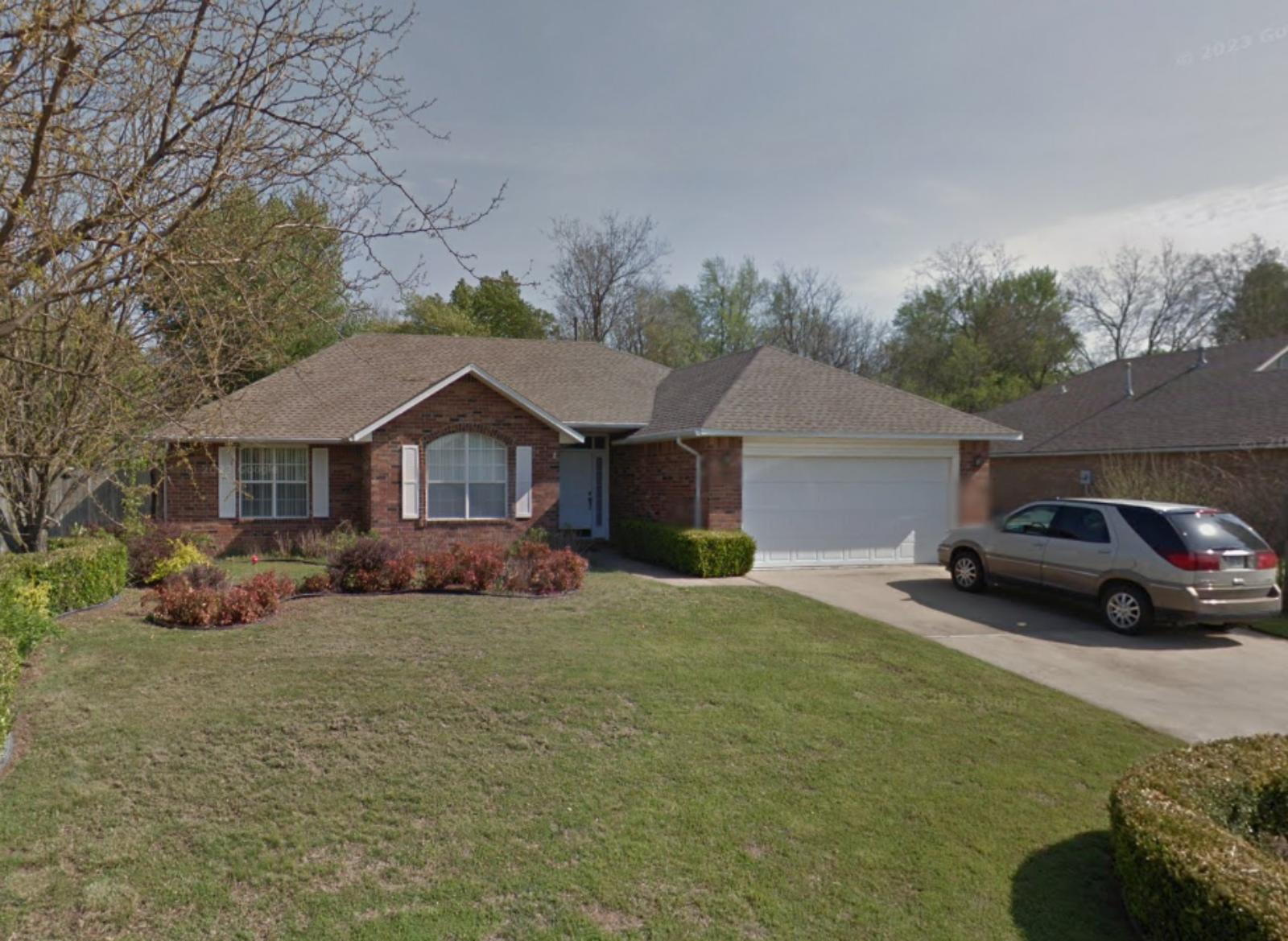
Farmington sits just a few miles southwest of Fayetteville, and its growth story over the past decade mirrors the expansion of Northwest Arkansas as a whole. Once a quiet town with farmland and sparse development, Farmington has increasingly become a commuter hub with new subdivisions, schools, and commercial amenities. That proximity to Fayetteville—home to the University of Arkansas—has made Farmington an appealing alternative for buyers priced out of the bigger city but still wanting convenient access to it. Improved road connectivity and school district performance have helped attract families, while the pace of new housing supply has struggled to keep up, pushing prices upward.
Unlike smaller rural towns, Farmington’s housing market is tied closely to broader economic activity in Washington County. As job opportunities grow in the region—especially in healthcare, education, and tech—more people are settling in Farmington for its lower density and slightly slower pace. The town has maintained a small-town vibe while gaining big-city proximity, and that combination has turned it into one of the state’s more in-demand suburban markets. With prices now approaching $330,000, the town is far from cheap, but it remains a more affordable alternative compared to Fayetteville proper—at least for now.
17. Springdale – 137.96% Home Price Increase Since 2010
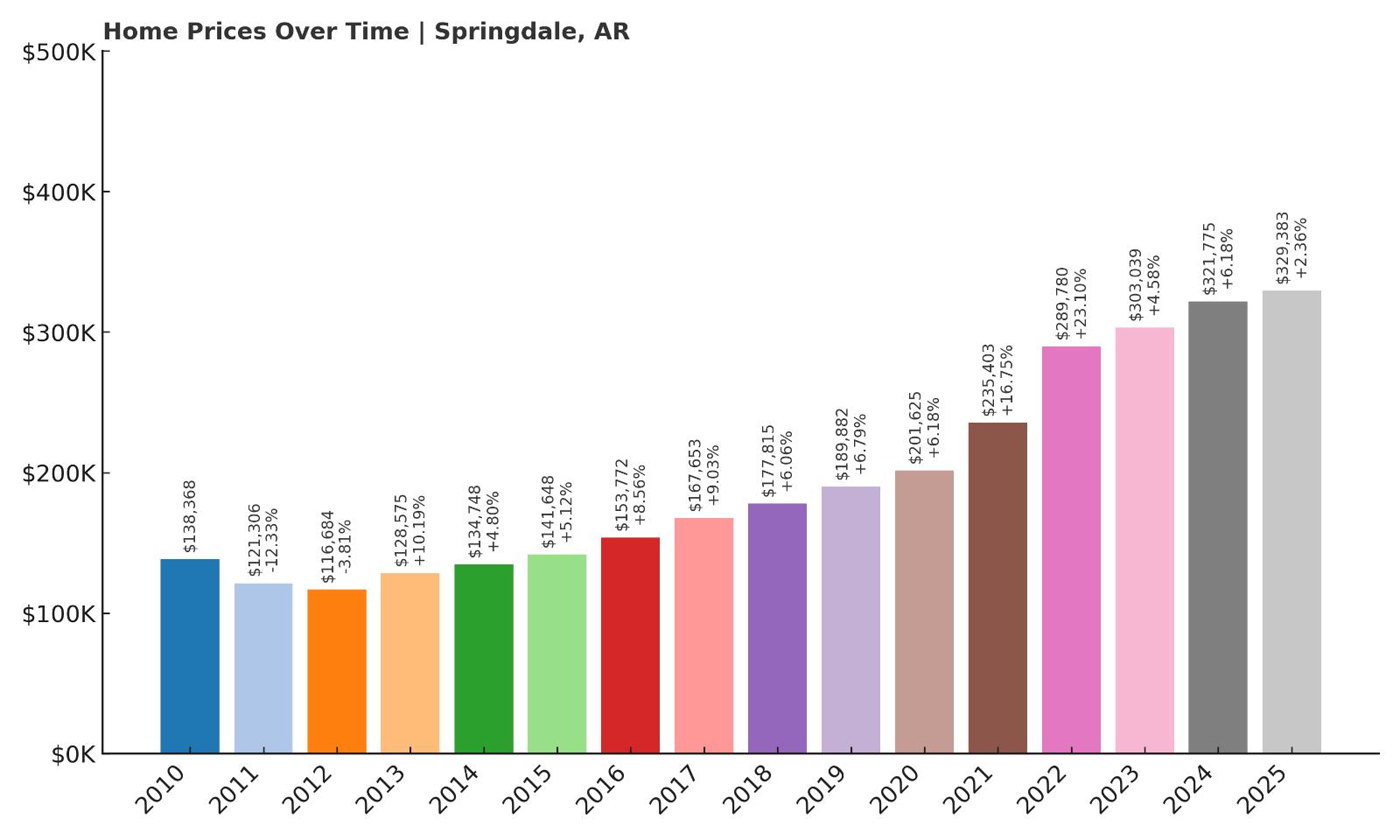
- 2010: $138,368.63
- 2011: $121,306.77 ($-17,061.86, -12.33% from previous year)
- 2012: $116,684.15 ($-4,622.62, -3.81% from previous year)
- 2013: $128,575.12 (+$11,890.97, +10.19% from previous year)
- 2014: $134,748.17 (+$6,173.05, +4.80% from previous year)
- 2015: $141,648.60 (+$6,900.43, +5.12% from previous year)
- 2016: $153,772.70 (+$12,124.10, +8.56% from previous year)
- 2017: $167,653.75 (+$13,881.05, +9.03% from previous year)
- 2018: $177,815.98 (+$10,162.23, +6.06% from previous year)
- 2019: $189,882.13 (+$12,066.15, +6.79% from previous year)
- 2020: $201,625.34 (+$11,743.21, +6.18% from previous year)
- 2021: $235,403.67 (+$33,778.33, +16.75% from previous year)
- 2022: $289,780.24 (+$54,376.57, +23.10% from previous year)
- 2023: $303,039.77 (+$13,259.53, +4.58% from previous year)
- 2024: $321,775.80 (+$18,736.03, +6.18% from previous year)
- 2025: $329,383.99 (+$7,608.19, +2.36% from previous year)
Springdale has seen one of the most dramatic turnarounds in Arkansas real estate, with home prices increasing 138% from 2010 to 2025. After back-to-back declines in 2011 and 2012, the market began rebounding strongly. Growth picked up even more in the late 2010s and exploded in 2021 and 2022, when prices surged by nearly $90,000 in just two years. Springdale is now among the top 20 most expensive towns in the state, with average home values above $329,000. The steady increases in recent years reflect Springdale’s growing appeal as a residential and economic hub in Northwest Arkansas.
Springdale – From Underrated to In Demand

Located between Fayetteville and Rogers, Springdale was once overshadowed by its more high-profile neighbors—but that’s no longer the case. Home to the headquarters of Tyson Foods and other major employers, the city has developed rapidly over the past decade. New developments, infrastructure improvements, and an expanding population have brought in more demand than ever before. As housing costs in nearby cities surged, Springdale emerged as a relatively affordable but well-connected option, driving both new construction and appreciation of existing homes. The city’s efforts to invest in parks, schools, and public amenities have also helped elevate its status across the region.
With a population of over 85,000, Springdale is one of the largest cities in Arkansas, and its housing market now reflects that scale. Prices are still slightly lower than in Bentonville or Rogers, but the gap is closing fast. Buyers are drawn to the combination of local job access and lower-than-peak prices, though inventory remains tight in many neighborhoods. As more families and young professionals settle in, the city is evolving fast—and its real estate values are responding accordingly. Springdale’s rise over the last decade has been steady and sharp, and the numbers suggest that trend is far from finished.
16. Johnson – 120.34% Home Price Increase Since 2010
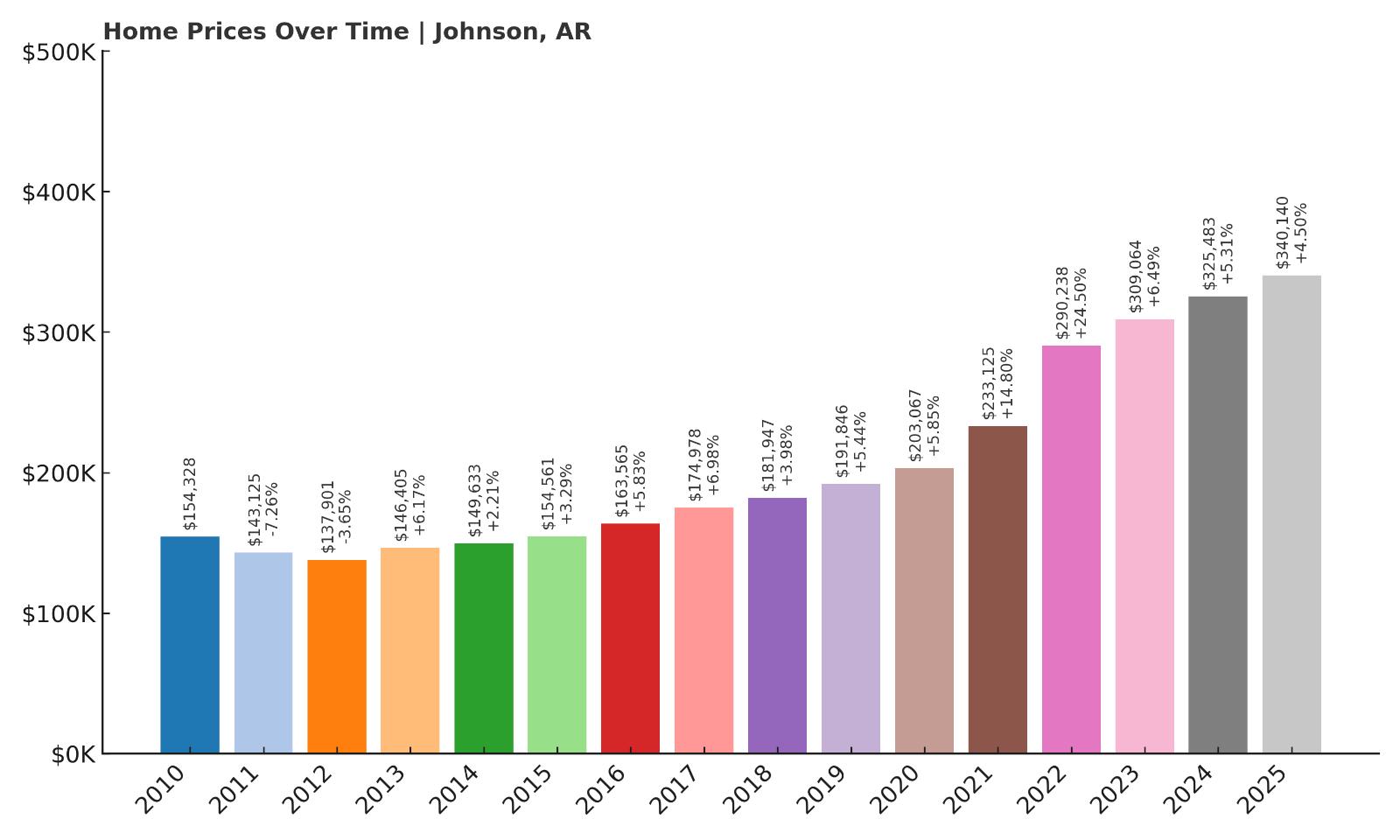
- 2010: $154,328.99
- 2011: $143,125.96 ($-11,203.03, -7.26% from previous year)
- 2012: $137,901.36 ($-5,224.60, -3.65% from previous year)
- 2013: $146,405.08 (+$8,503.72, +6.17% from previous year)
- 2014: $149,633.78 (+$3,228.70, +2.21% from previous year)
- 2015: $154,561.29 (+$4,927.51, +3.29% from previous year)
- 2016: $163,565.11 (+$9,003.82, +5.83% from previous year)
- 2017: $174,978.22 (+$11,413.11, +6.98% from previous year)
- 2018: $181,947.60 (+$6,969.38, +3.98% from previous year)
- 2019: $191,846.85 (+$9,899.25, +5.44% from previous year)
- 2020: $203,067.35 (+$11,220.50, +5.85% from previous year)
- 2021: $233,125.91 (+$30,058.56, +14.80% from previous year)
- 2022: $290,238.63 (+$57,112.72, +24.50% from previous year)
- 2023: $309,064.68 (+$18,826.05, +6.49% from previous year)
- 2024: $325,483.55 (+$16,418.87, +5.31% from previous year)
- 2025: $340,140.42 (+$14,656.87, +4.50% from previous year)
Johnson’s home prices have climbed 120.34% since 2010, moving from the low $150,000s to more than $340,000 in 2025. The growth has been steady with no major volatility, but two years stand out: 2021 and 2022, when values jumped by over $87,000 combined. Before that, the market showed gradual year-over-year increases, a sign of growing but measured demand. Even in recent years, growth has continued at a solid pace, keeping Johnson on the map as one of the state’s most consistently appreciating towns. With few downturns and a clean upward trajectory, the price trend points to long-term strength rather than speculative spikes.
Johnson – Quiet Growth at the Center of It All
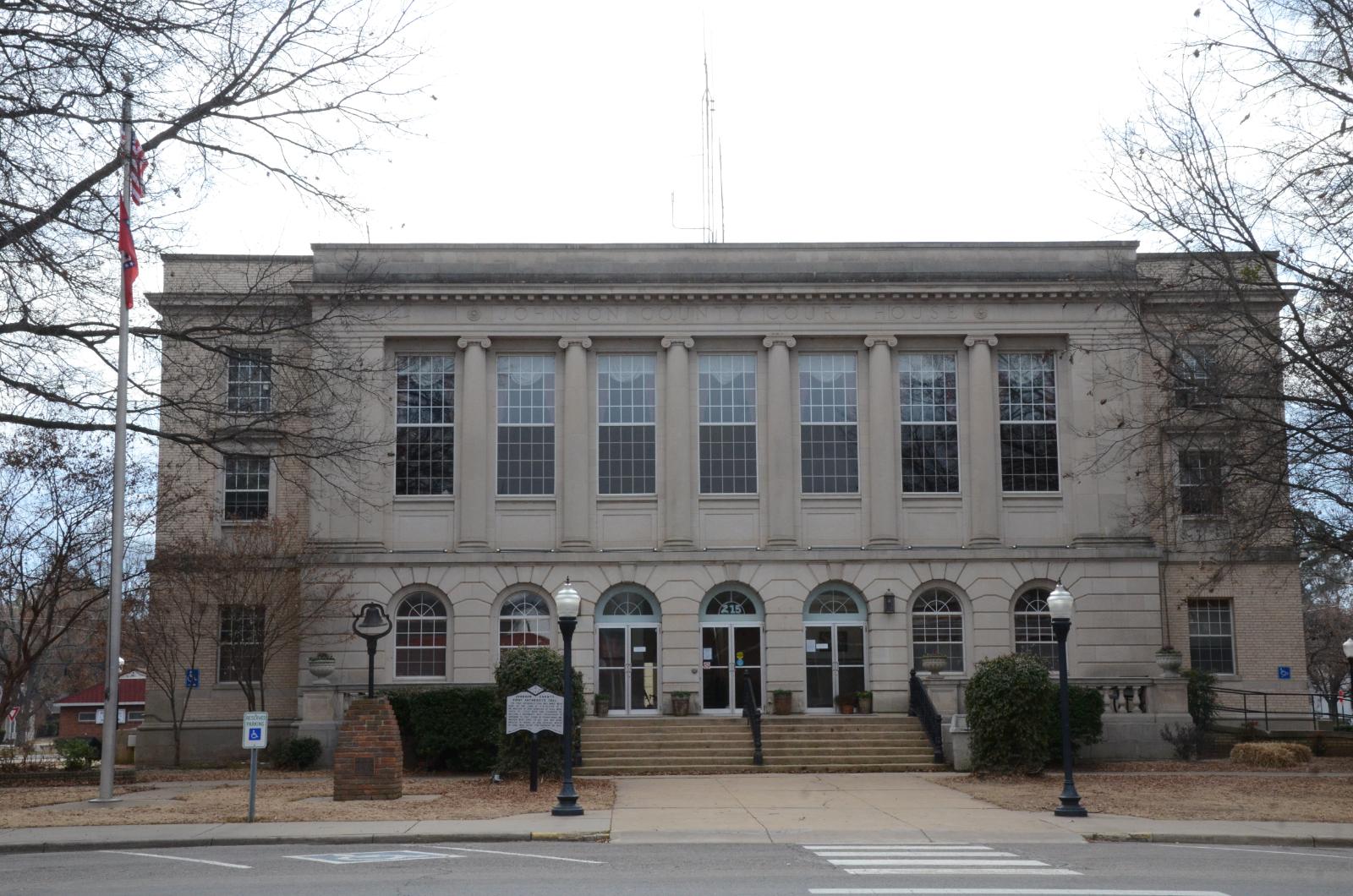
Johnson is a small but strategic community tucked between Fayetteville and Springdale. With just a few thousand residents, it offers a quieter alternative to its larger neighbors while still enjoying access to the same amenities and job markets. That balance makes it especially attractive to buyers seeking space without sacrificing location. Despite its size, Johnson has seen major residential development over the last decade, including new subdivisions and higher-end homes that have elevated the town’s average value. Its schools, greenways, and proximity to I-49 make it a top pick for Northwest Arkansas families and commuters alike.
One of Johnson’s advantages is that it has room to grow—but is doing so in a controlled way. The town has managed to preserve its residential feel even as new development arrives, which appeals to buyers tired of congestion in neighboring cities. As larger cities like Fayetteville and Springdale continue expanding, Johnson’s location becomes even more valuable. Recent price increases haven’t priced out most middle-income buyers yet, but the upward trend suggests that window may be closing. For now, Johnson remains one of Arkansas’s most stable—and steadily rising—real estate bets.
15. Bethel Heights – 134.75% Home Price Increase Since 2010
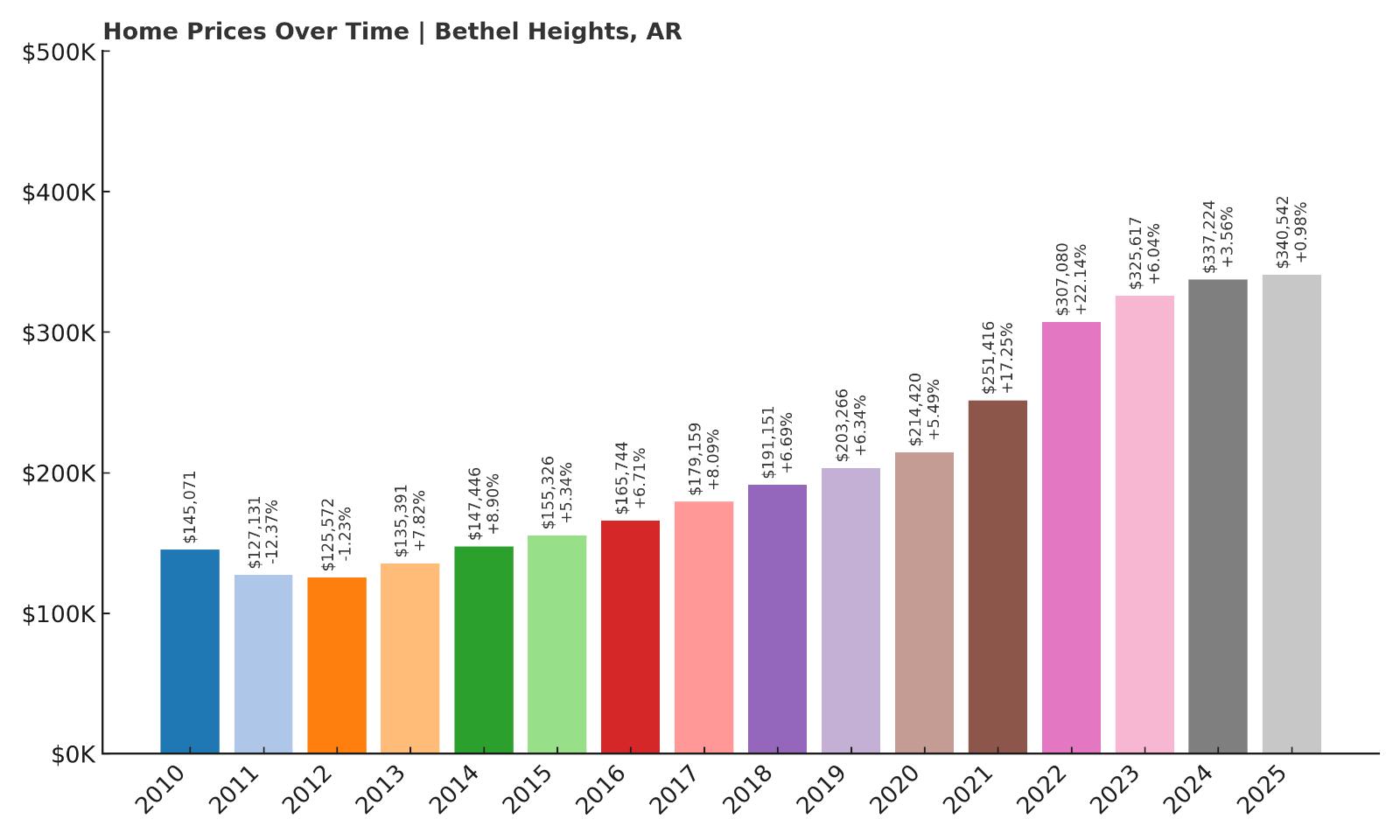
- 2010: $145,071.55
- 2011: $127,131.38 ($-17,940.17, -12.37% from previous year)
- 2012: $125,572.58 ($-1,558.80, -1.23% from previous year)
- 2013: $135,391.01 (+$9,818.43, +7.82% from previous year)
- 2014: $147,446.30 (+$12,055.29, +8.90% from previous year)
- 2015: $155,326.07 (+$7,879.77, +5.34% from previous year)
- 2016: $165,744.42 (+$10,418.35, +6.71% from previous year)
- 2017: $179,159.39 (+$13,414.97, +8.09% from previous year)
- 2018: $191,151.59 (+$11,992.20, +6.69% from previous year)
- 2019: $203,266.47 (+$12,114.88, +6.34% from previous year)
- 2020: $214,420.93 (+$11,154.46, +5.49% from previous year)
- 2021: $251,416.98 (+$36,996.05, +17.25% from previous year)
- 2022: $307,080.68 (+$55,663.70, +22.14% from previous year)
- 2023: $325,617.78 (+$18,537.10, +6.04% from previous year)
- 2024: $337,224.36 (+$11,606.58, +3.56% from previous year)
- 2025: $340,542.74 (+$3,318.38, +0.98% from previous year)
Bethel Heights has seen home prices surge by nearly 135% since 2010, moving from just over $145,000 to more than $340,000 in 2025. The early years showed a decline, with values falling over 12% in 2011 and continuing downward into 2012. However, from 2013 onward, the town experienced strong, steady appreciation year after year. The largest jumps occurred in 2021 and 2022, when prices rose by over $90,000 across two years, followed by slower but still positive growth. The rate of increase has eased in 2024 and 2025, suggesting a stabilizing market. Overall, the upward trajectory reflects the town’s evolution into one of the region’s more desirable residential areas. For a place once overlooked, Bethel Heights now commands high prices that rival more prominent cities nearby.
Bethel Heights – From Rural Roots to Real Estate Magnet
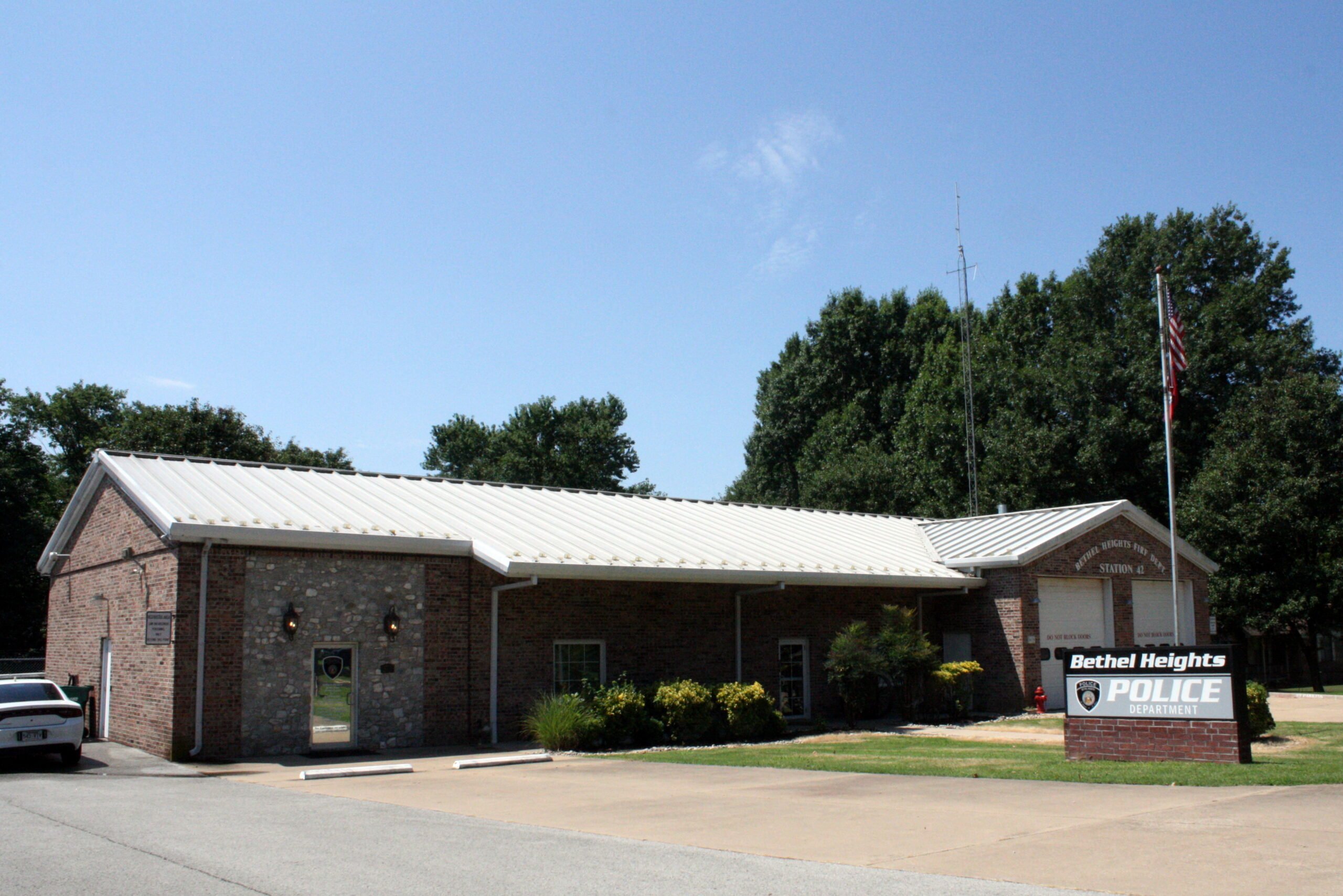
Bethel Heights, located in Benton County, has undergone one of the most remarkable transformations in Northwest Arkansas. Once a small agricultural settlement between Springdale and Lowell, the town experienced a development boom in the 2010s as demand for affordable land and housing close to I-49 grew. Its annexation into the city of Springdale in recent years helped boost infrastructure investment, from upgraded roads to improved utility access, which in turn made the area more attractive for large-scale residential projects. The town’s location at the junction of several commuter corridors made it a natural candidate for spillover demand as Springdale and Fayetteville grew more expensive. While new development helped raise housing stock, it also pushed values higher, especially as demand from families and first-time buyers intensified.
Even with modest retail and commercial activity, Bethel Heights appeals to buyers for its access, quiet neighborhoods, and lower density compared to larger cities. The real estate market here is largely driven by suburban growth—platted subdivisions with single-family homes that offer more space for the money. That dynamic has led to rapid price increases, especially when post-pandemic remote work trends led more buyers to seek roomier, less urban options. While recent years show a cooling from the frenetic growth of 2021–2022, home prices remain elevated and have settled at a much higher baseline than a decade ago. For buyers entering the market now, Bethel Heights offers access to Northwest Arkansas’s economic engine—but they’ll pay a premium for it compared to just a few years back.
14. Pea Ridge – 171.38% Home Price Increase Since 2010
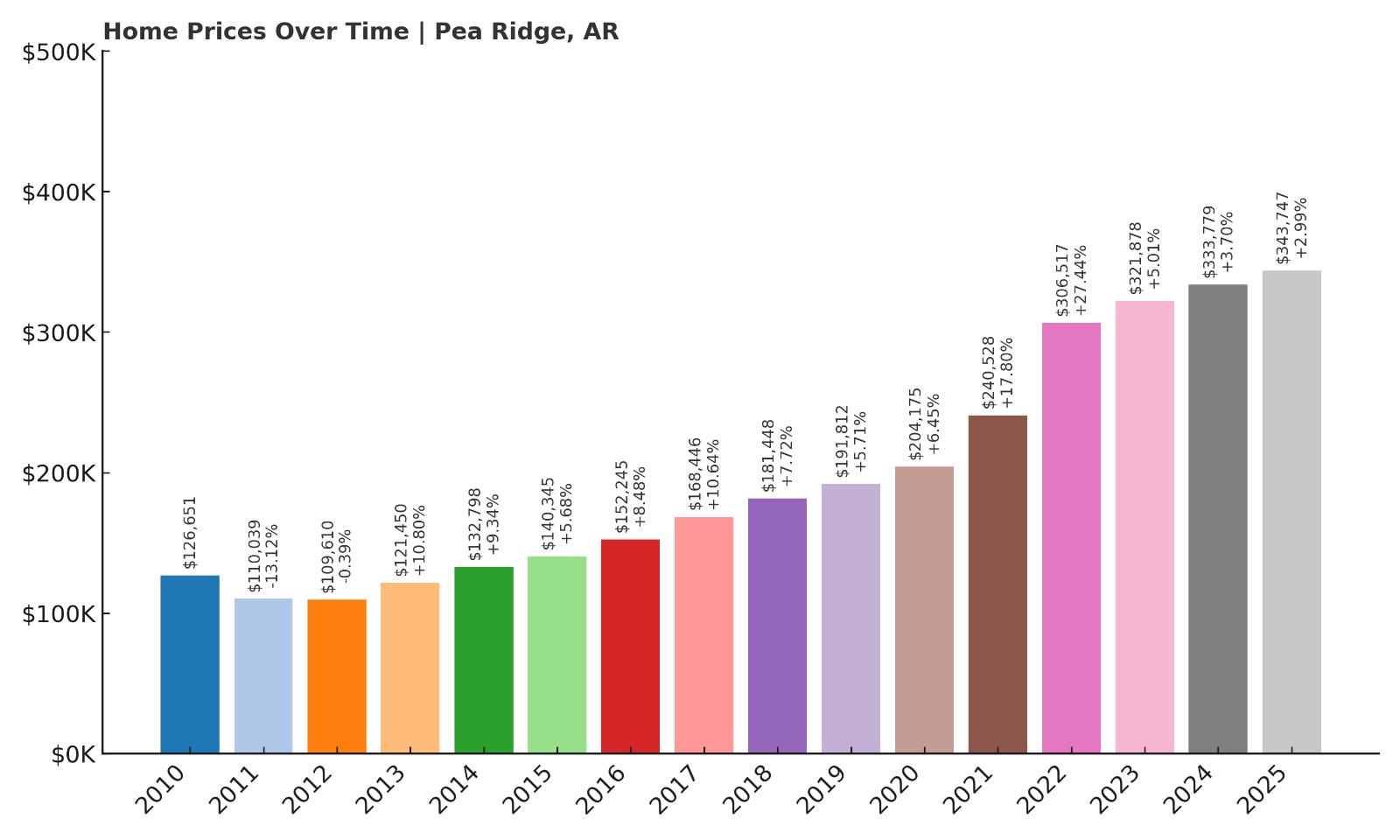
- 2010: $126,651.71
- 2011: $110,039.29 ($-16,612.42, -13.12% from previous year)
- 2012: $109,610.72 ($-428.57, -0.39% from previous year)
- 2013: $121,450.42 (+$11,839.70, +10.80% from previous year)
- 2014: $132,798.03 (+$11,347.61, +9.34% from previous year)
- 2015: $140,345.85 (+$7,547.82, +5.68% from previous year)
- 2016: $152,245.74 (+$11,899.89, +8.48% from previous year)
- 2017: $168,446.06 (+$16,200.32, +10.64% from previous year)
- 2018: $181,448.51 (+$13,002.45, +7.72% from previous year)
- 2019: $191,812.67 (+$10,364.16, +5.71% from previous year)
- 2020: $204,175.89 (+$12,363.22, +6.45% from previous year)
- 2021: $240,528.24 (+$36,352.35, +17.80% from previous year)
- 2022: $306,517.76 (+$65,989.52, +27.44% from previous year)
- 2023: $321,878.47 (+$15,360.71, +5.01% from previous year)
- 2024: $333,779.85 (+$11,901.38, +3.70% from previous year)
- 2025: $343,747.34 (+$9,967.49, +2.99% from previous year)
Home values in Pea Ridge have surged by more than 171% since 2010, climbing from around $126,000 to nearly $344,000 in 2025. While there were early setbacks during the post-recession period, the town’s price trajectory has been one of Arkansas’s steepest over the past decade. Prices grew at a strong pace throughout the 2010s but truly exploded in 2021 and 2022, when values jumped by more than $100,000 combined in just two years. Since then, price growth has cooled slightly but continues on a steady upward trend. This impressive performance reflects Pea Ridge’s emergence as one of the top-tier residential destinations in the state’s booming northwest corridor.
Pea Ridge – A New Frontier in Northwest Arkansas
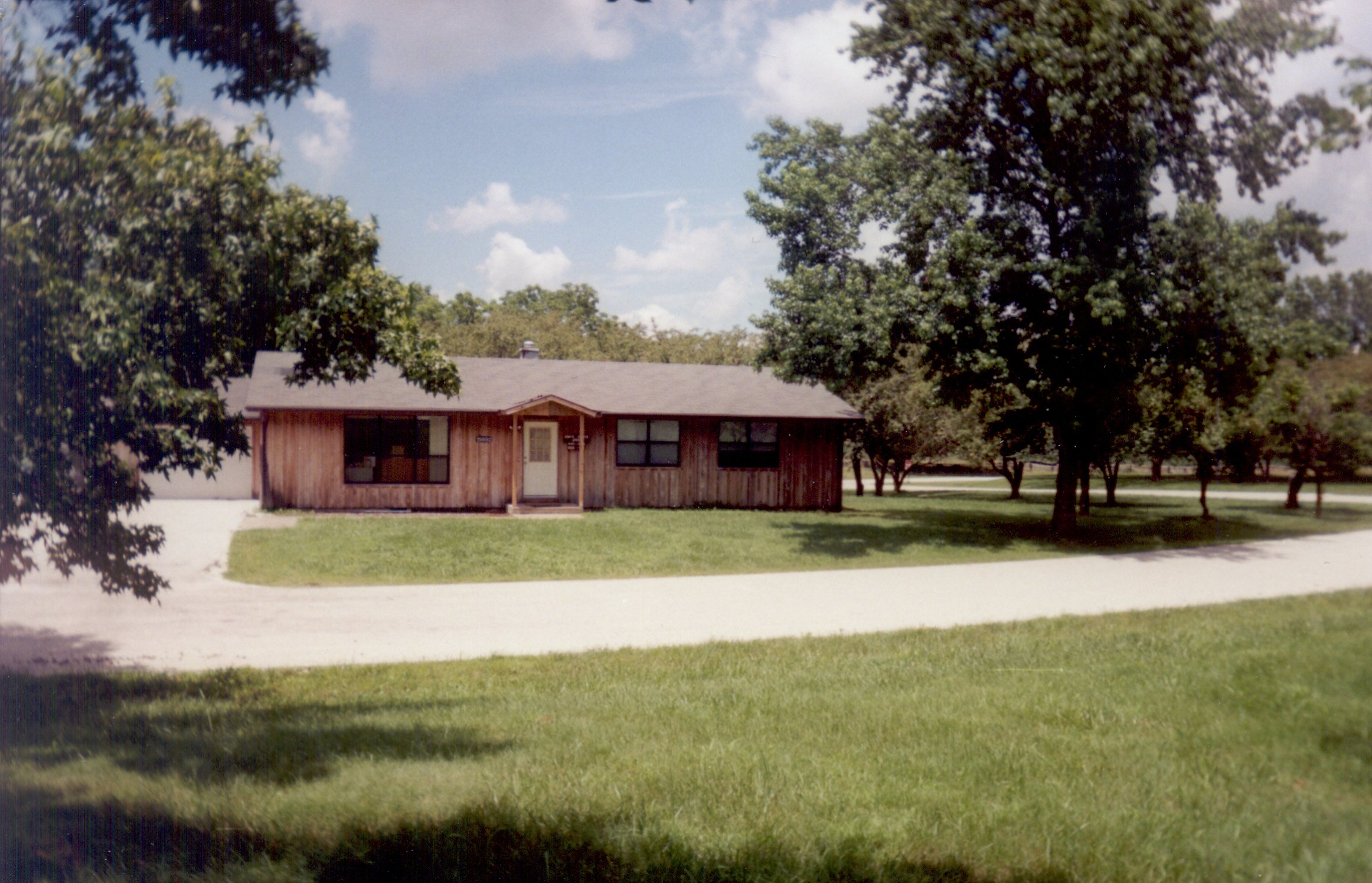
Pea Ridge has rapidly evolved from a small, historic town into one of the fastest-growing residential areas in Benton County. Its location north of Rogers makes it a prime spot for buyers seeking affordable alternatives without compromising access to jobs, schools, and amenities. The town’s school district has earned strong reviews, contributing to demand among families moving into the region. Infrastructure improvements, including widened highways and new housing developments, have further fueled population growth. Pea Ridge offers a mix of small-town charm and suburban convenience, which has made it increasingly attractive to buyers priced out of Bentonville or Rogers but still eager to live nearby. The housing stock has expanded, but not fast enough to meet the influx of interest—driving sharp appreciation.
Unlike some neighboring towns, Pea Ridge still retains visible signs of its past as a rural farming community, with open tracts of land and scenic views around its edges. This blend of old and new has added to its appeal, especially as remote work allows more people to live farther from urban centers. Real estate developers have taken notice, and new subdivisions continue to spring up on the town’s outskirts, though demand continues to outpace supply. The town’s price growth reflects both its strategic location and its growing profile within the regional economy. With strong fundamentals and ongoing demand, Pea Ridge has transformed into a destination for upward mobility in Arkansas real estate—and that momentum doesn’t appear to be slowing down anytime soon.
13. Gravette – 254.35% Home Price Increase Since 2010
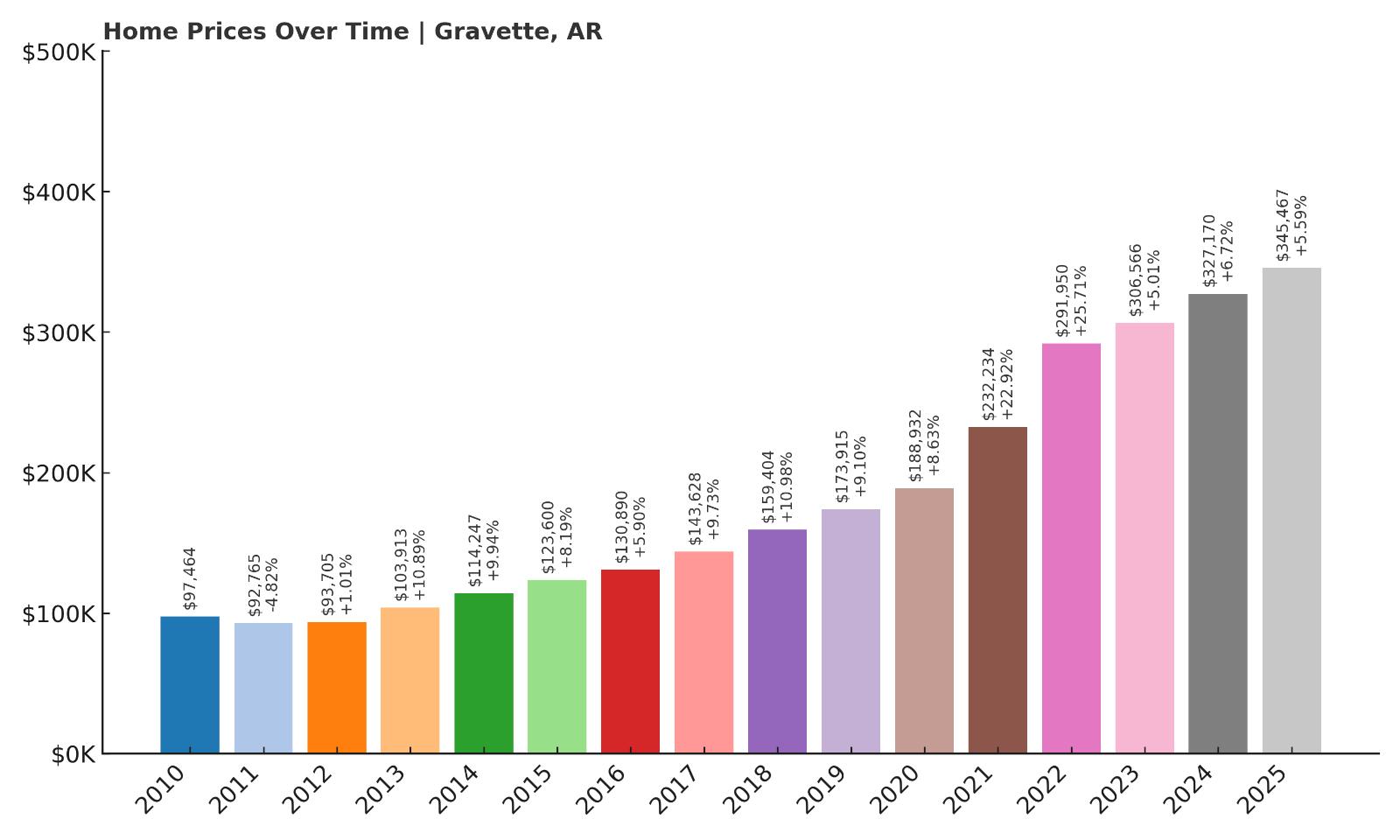
- 2010: $97,464.61
- 2011: $92,765.58 ($-4,699.03, -4.82% from previous year)
- 2012: $93,705.33 (+$939.75, +1.01% from previous year)
- 2013: $103,913.80 (+$10,208.47, +10.89% from previous year)
- 2014: $114,247.48 (+$10,333.68, +9.94% from previous year)
- 2015: $123,600.93 (+$9,353.45, +8.19% from previous year)
- 2016: $130,890.07 (+$7,289.14, +5.90% from previous year)
- 2017: $143,628.92 (+$12,738.85, +9.73% from previous year)
- 2018: $159,404.85 (+$15,775.93, +10.98% from previous year)
- 2019: $173,915.46 (+$14,510.61, +9.10% from previous year)
- 2020: $188,932.38 (+$15,016.92, +8.63% from previous year)
- 2021: $232,234.29 (+$43,301.91, +22.92% from previous year)
- 2022: $291,950.70 (+$59,716.41, +25.71% from previous year)
- 2023: $306,566.18 (+$14,615.48, +5.01% from previous year)
- 2024: $327,170.66 (+$20,604.48, +6.72% from previous year)
- 2025: $345,467.32 (+$18,296.66, +5.59% from previous year)
Gravette’s home prices have increased by more than 254% since 2010—the sharpest growth rate so far on this list. What began as a modest market under $100,000 has transformed into one of Northwest Arkansas’s hottest housing zones, with average home values topping $345,000 in 2025. The price gains were steady throughout the 2010s but picked up sharply beginning in 2020, culminating in back-to-back surges of over 20% in both 2021 and 2022. Since then, the market has continued climbing, though at a more moderate pace. This data signals not only sustained demand but also Gravette’s transformation from a rural town into a booming residential destination.
Gravette – Explosive Growth at the Region’s Edge

Gravette sits in the far northwest corner of Arkansas, just minutes from the Missouri border. Historically a small, agricultural town, it has become one of the fastest-growing real estate markets in the state—largely due to its position near the expanding Bentonville-Rogers metro. As those more urban markets became crowded and expensive, Gravette emerged as an attractive alternative, offering land, newer construction, and suburban-style living at lower prices. That value proposition attracted families and developers alike, triggering a rapid rise in new home construction. Improved connectivity via U.S. Route 59 and nearby highways has only increased its draw, especially for commuters working in Bentonville’s booming corporate ecosystem.
Unlike some towns on this list, Gravette’s growth feels turbocharged—fueled by a mix of affordability, new development, and spillover demand from the tech and logistics boom in the region. Many of the homes being built in the last decade are part of planned communities with modern amenities, appealing to both local buyers and out-of-state transplants. The town is investing in schools and infrastructure to keep up, but that hasn’t slowed demand. With values now more than tripling since 2010, Gravette no longer flies under the radar. It has cemented itself as one of Arkansas’s new real estate powerhouses, and its rising prices suggest continued confidence in the town’s long-term prospects.
12. Lowell – 161.86% Home Price Increase Since 2010
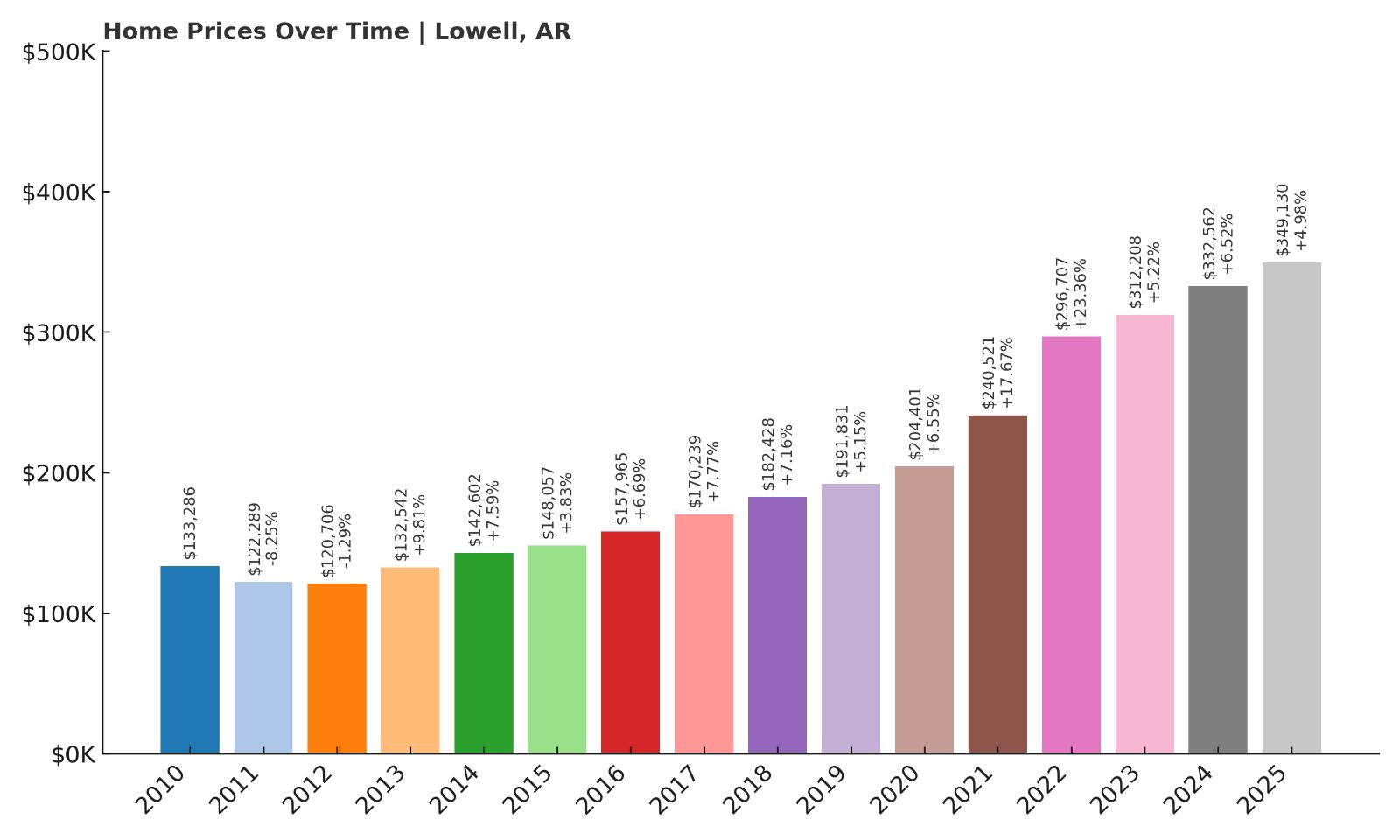
- 2010: $133,286.63
- 2011: $122,289.64 ($-10,996.99, -8.25% from previous year)
- 2012: $120,706.52 ($-1,583.12, -1.29% from previous year)
- 2013: $132,542.50 (+$11,835.98, +9.81% from previous year)
- 2014: $142,602.84 (+$10,060.34, +7.59% from previous year)
- 2015: $148,057.79 (+$5,454.95, +3.83% from previous year)
- 2016: $157,965.08 (+$9,907.29, +6.69% from previous year)
- 2017: $170,239.51 (+$12,274.43, +7.77% from previous year)
- 2018: $182,428.17 (+$12,188.66, +7.16% from previous year)
- 2019: $191,831.98 (+$9,403.81, +5.15% from previous year)
- 2020: $204,401.58 (+$12,569.60, +6.55% from previous year)
- 2021: $240,521.76 (+$36,120.18, +17.67% from previous year)
- 2022: $296,707.35 (+$56,185.59, +23.36% from previous year)
- 2023: $312,208.32 (+$15,500.97, +5.22% from previous year)
- 2024: $332,562.01 (+$20,353.69, +6.52% from previous year)
- 2025: $349,130.46 (+$16,568.45, +4.98% from previous year)
Home values in Lowell have risen by nearly 162% since 2010, surging from roughly $133,000 to over $349,000 as of May 2025. After early declines in 2011 and 2012, prices began rising rapidly, especially in the years following 2020. The twin spikes in 2021 and 2022 added more than $90,000 in just 24 months. Even after that, growth remained healthy, with the market showing consistent increases through 2025. Lowell’s affordability and proximity to major job centers have made it a target for homebuyers seeking both convenience and value. Its upward trend now puts it squarely in Arkansas’s high-price tier for residential property.
Lowell – A Commuter Town on the Rise
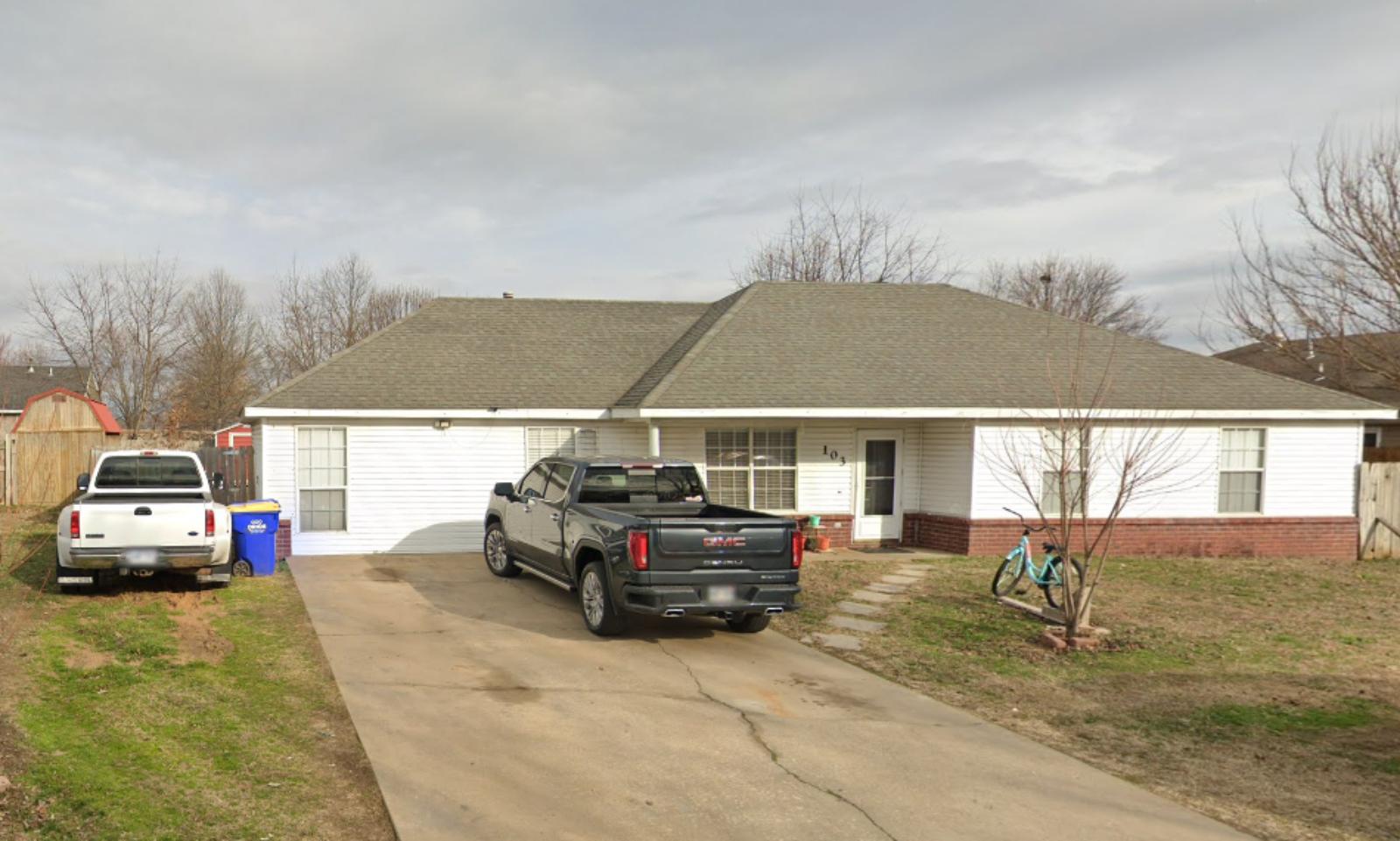
Lowell is strategically situated between Fayetteville and Rogers, making it an ideal location for commuters and families who want fast access to work and amenities without the crowds of a bigger city. Over the last decade, the town has seen a wave of suburban development, with new subdivisions, retail centers, and school expansions helping reshape its reputation. Once a sleepy residential zone, Lowell is now one of Benton County’s most desirable addresses. It offers a strong school district, ample green space, and low crime rates—three key factors that continue to attract buyers. The pace of development has brought new life to the local economy, even as housing inventory struggles to keep up with demand.
One of Lowell’s greatest assets is its connectivity. Located right off Interstate 49, it’s a short drive to both Walmart HQ in Bentonville and the University of Arkansas in Fayetteville. That central position has made it a magnet for professionals looking to balance career access with quality of life. As prices soared in neighboring towns, Lowell’s relative affordability brought it to the forefront. Now, with average home values approaching $350,000, Lowell is no longer just the affordable option—it’s a prime destination in its own right. Continued infrastructure investments and population growth point toward further appreciation, making it one of the region’s most reliable real estate bets for 2025 and beyond.
11. Centerton – 157.82% Home Price Increase Since 2010
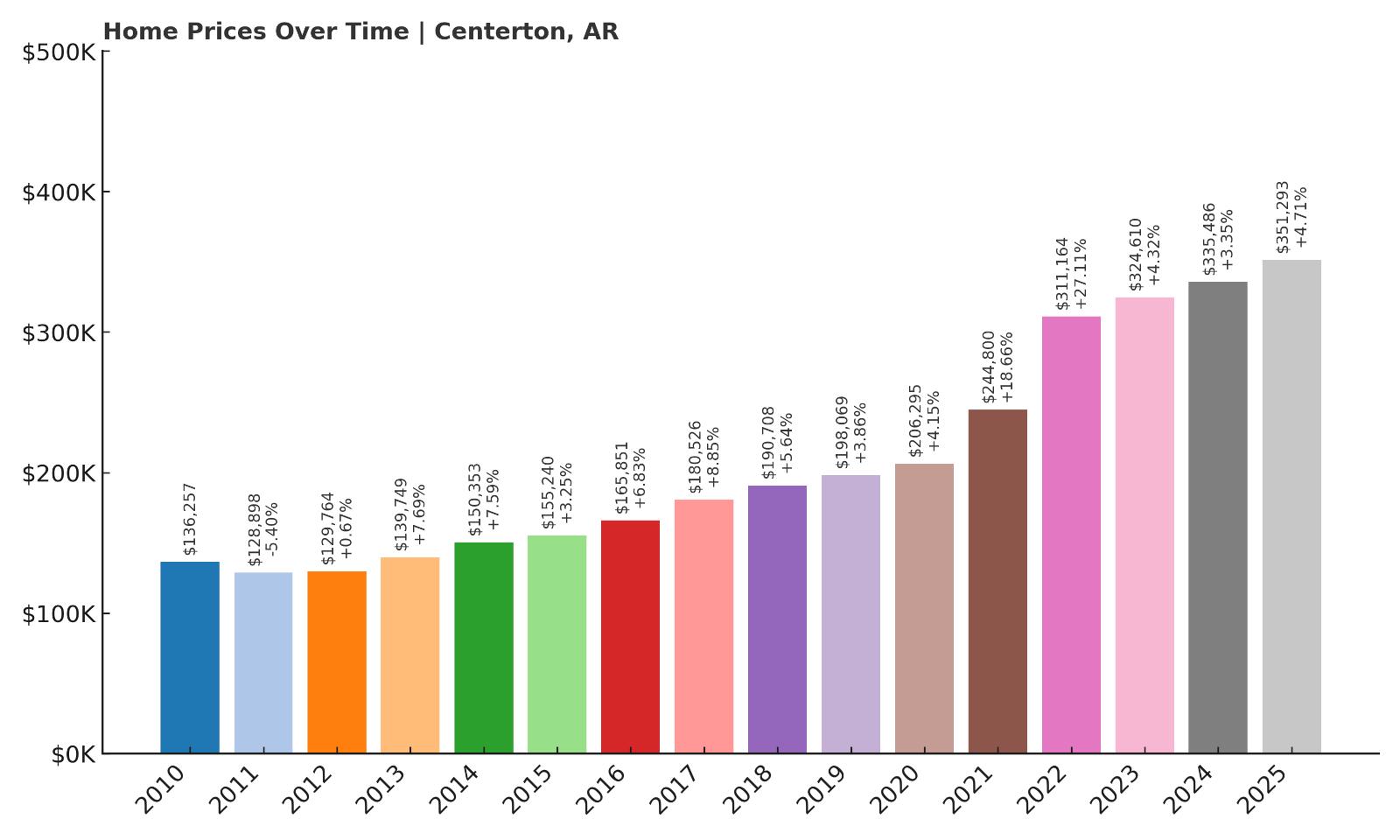
- 2010: $136,257.44
- 2011: $128,898.62 ($-7,358.82, -5.40% from previous year)
- 2012: $129,764.54 (+$865.92, +0.67% from previous year)
- 2013: $139,749.42 (+$9,984.88, +7.69% from previous year)
- 2014: $150,353.26 (+$10,603.84, +7.59% from previous year)
- 2015: $155,240.94 (+$4,887.68, +3.25% from previous year)
- 2016: $165,851.55 (+$10,610.61, +6.83% from previous year)
- 2017: $180,526.14 (+$14,674.59, +8.85% from previous year)
- 2018: $190,708.27 (+$10,182.13, +5.64% from previous year)
- 2019: $198,069.00 (+$7,360.73, +3.86% from previous year)
- 2020: $206,295.60 (+$8,226.60, +4.15% from previous year)
- 2021: $244,800.60 (+$38,505.00, +18.66% from previous year)
- 2022: $311,164.15 (+$66,363.55, +27.11% from previous year)
- 2023: $324,610.22 (+$13,446.07, +4.32% from previous year)
- 2024: $335,486.64 (+$10,876.42, +3.35% from previous year)
- 2025: $351,293.10 (+$15,806.46, +4.71% from previous year)
Centerton’s average home value has climbed from $136,000 in 2010 to over $351,000 in 2025, marking a 157.82% increase. The town’s growth began gradually, with steady increases throughout the 2010s, but it accelerated sharply after 2020. The 2021–2022 period saw a staggering $100,000 rise, highlighting how quickly Centerton moved from affordable suburb to expensive destination. Since then, growth has moderated, but home values remain on the rise. The numbers reflect both strong local demand and the broader economic magnetism of Benton County. For those watching Northwest Arkansas’s real estate boom, Centerton is no longer a secondary market—it’s a major player.
Centerton – From Bedroom Community to Housing Hotspot

Centerton began as a quiet bedroom community for Bentonville, but over the past decade, it’s grown into a destination in its own right. With new schools, modern infrastructure, and rapid residential development, the town now competes directly with its larger neighbors. Its affordability compared to Bentonville helped drive demand through the 2010s, especially among young families and professionals working in Walmart’s orbit. As new homebuilders flocked to the area, Centerton became a canvas for modern subdivisions and master-planned communities. Many homes built since 2015 feature updated layouts, energy-efficient design, and smart-home tech—adding to their long-term value. The pace of change has been rapid, and the town has done well to keep up with expanding population needs.
Located just west of Bentonville, Centerton benefits immensely from its geography. It offers residents a quieter, less congested lifestyle while still sitting minutes from the region’s corporate and cultural core. The city is home to a growing list of local businesses and services, but most residents also tap into the broader amenities of Northwest Arkansas. With continued investment in education, parks, and roadways, Centerton has positioned itself as more than a commuter town—it’s a self-sustaining residential hub. The post-pandemic surge in remote and hybrid work has only increased its appeal. With home prices now well above $350,000, Centerton’s growth story appears far from finished, and the market signals point to continued strength in the years ahead.
10. Bella Vista – 143.49% Home Price Increase Since 2010
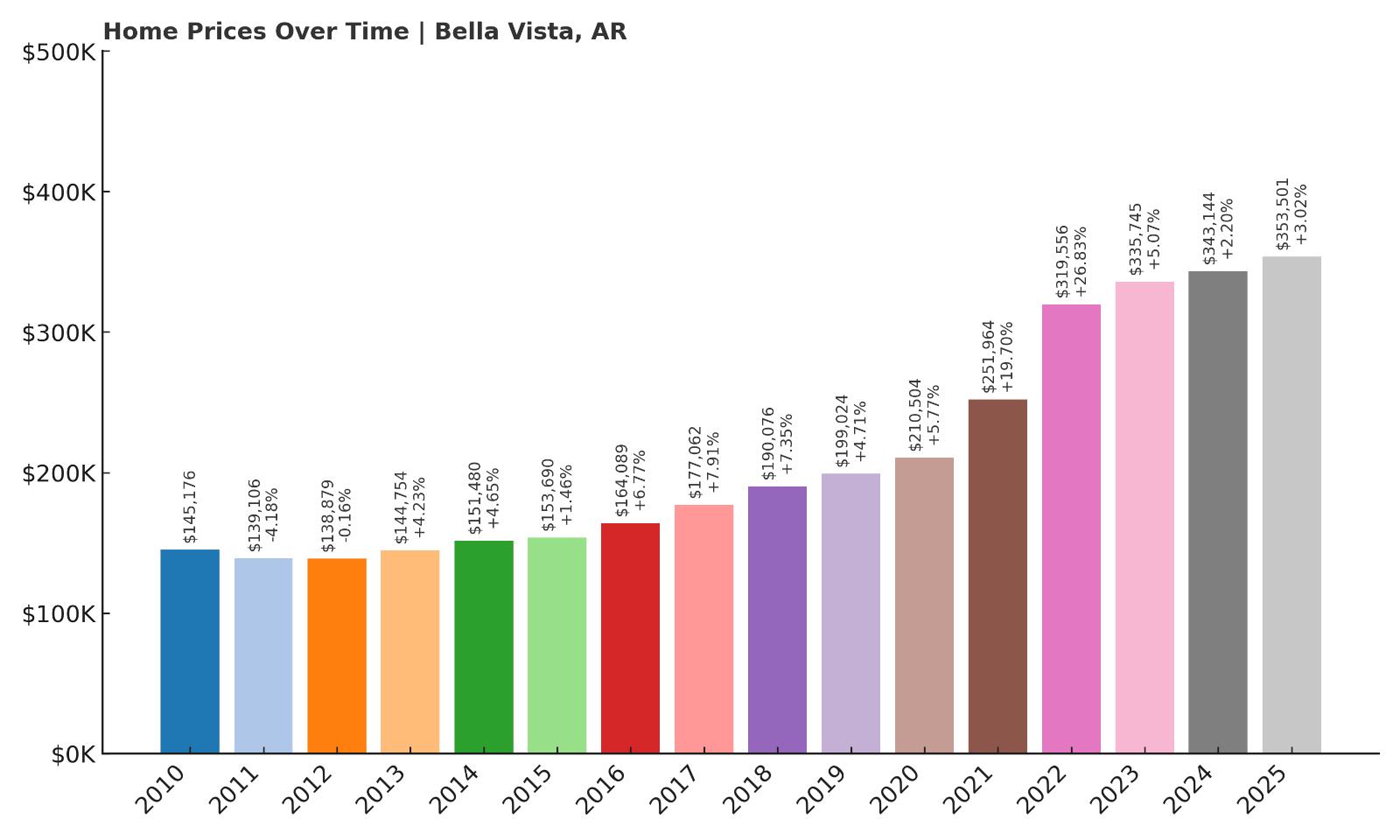
- 2010: $145,176.17
- 2011: $139,106.19 ($-6,069.98, -4.18% from previous year)
- 2012: $138,879.91 ($-226.28, -0.16% from previous year)
- 2013: $144,754.83 (+$5,874.92, +4.23% from previous year)
- 2014: $151,480.36 (+$6,725.53, +4.65% from previous year)
- 2015: $153,690.24 (+$2,209.88, +1.46% from previous year)
- 2016: $164,089.58 (+$10,399.34, +6.77% from previous year)
- 2017: $177,062.49 (+$12,972.91, +7.91% from previous year)
- 2018: $190,076.48 (+$13,013.99, +7.35% from previous year)
- 2019: $199,024.47 (+$8,947.99, +4.71% from previous year)
- 2020: $210,504.51 (+$11,480.04, +5.77% from previous year)
- 2021: $251,964.04 (+$41,459.53, +19.70% from previous year)
- 2022: $319,556.98 (+$67,592.94, +26.83% from previous year)
- 2023: $335,745.53 (+$16,188.55, +5.07% from previous year)
- 2024: $343,144.35 (+$7,398.82, +2.20% from previous year)
- 2025: $353,501.55 (+$10,357.20, +3.02% from previous year)
Bella Vista has seen home prices increase by more than 143% since 2010, rising from just under $145,200 to $353,500 by 2025. While the early 2010s showed modest gains and even some small losses, the town’s housing market took off in the second half of the decade. The biggest growth came between 2020 and 2022, when home values rose by more than $100,000 across just two years. That was followed by steady increases through 2025, showing continued resilience in one of Arkansas’s most unique residential markets. With prices now rivaling those in much larger cities, Bella Vista has firmly secured a place among the state’s most expensive towns.
Bella Vista – Master-Planned Living Surrounded by Nature
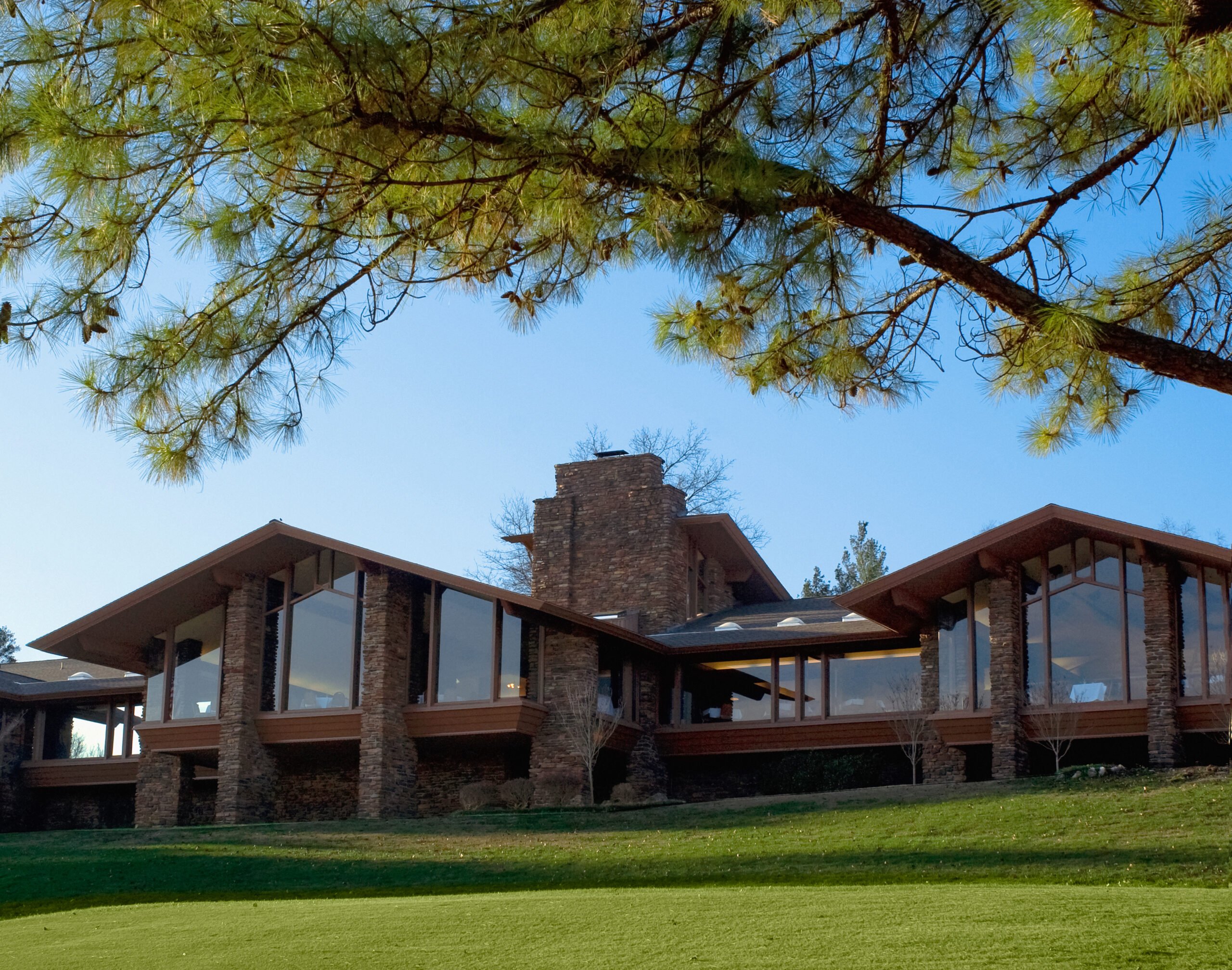
Bella Vista’s origins as a retirement community have evolved into something much broader. Located at the northern edge of Benton County and bordering Missouri, the city is now home to a diverse population of full-time residents, many of whom are drawn by its master-planned design and natural amenities. With seven lakes, multiple golf courses, extensive trails, and a system of interconnected neighborhoods, Bella Vista offers a lifestyle that few other towns in the state can match. The area is especially appealing to outdoor enthusiasts and remote workers looking for a quieter setting. As Northwest Arkansas has boomed, Bella Vista has benefited from its proximity to Bentonville while maintaining its low-density, wooded charm.
The city’s popularity during the pandemic era reflected a broader shift in buyer priorities: people wanted space, natural beauty, and livable communities, and Bella Vista had all of that in abundance. This fueled the rapid appreciation seen in 2021 and 2022, when thousands of new buyers entered the market, many of them from out of state. New home construction has occurred, but much of the inventory consists of established homes within planned neighborhoods—contributing to continued pressure on supply. Despite the recent pace of growth slowing slightly, demand remains strong. Bella Vista’s real estate market has matured into one of the most desirable in Arkansas, especially for those seeking scenic living within commuting distance of urban employers.
9. Hindsville – 131.45% Home Price Increase Since 2010
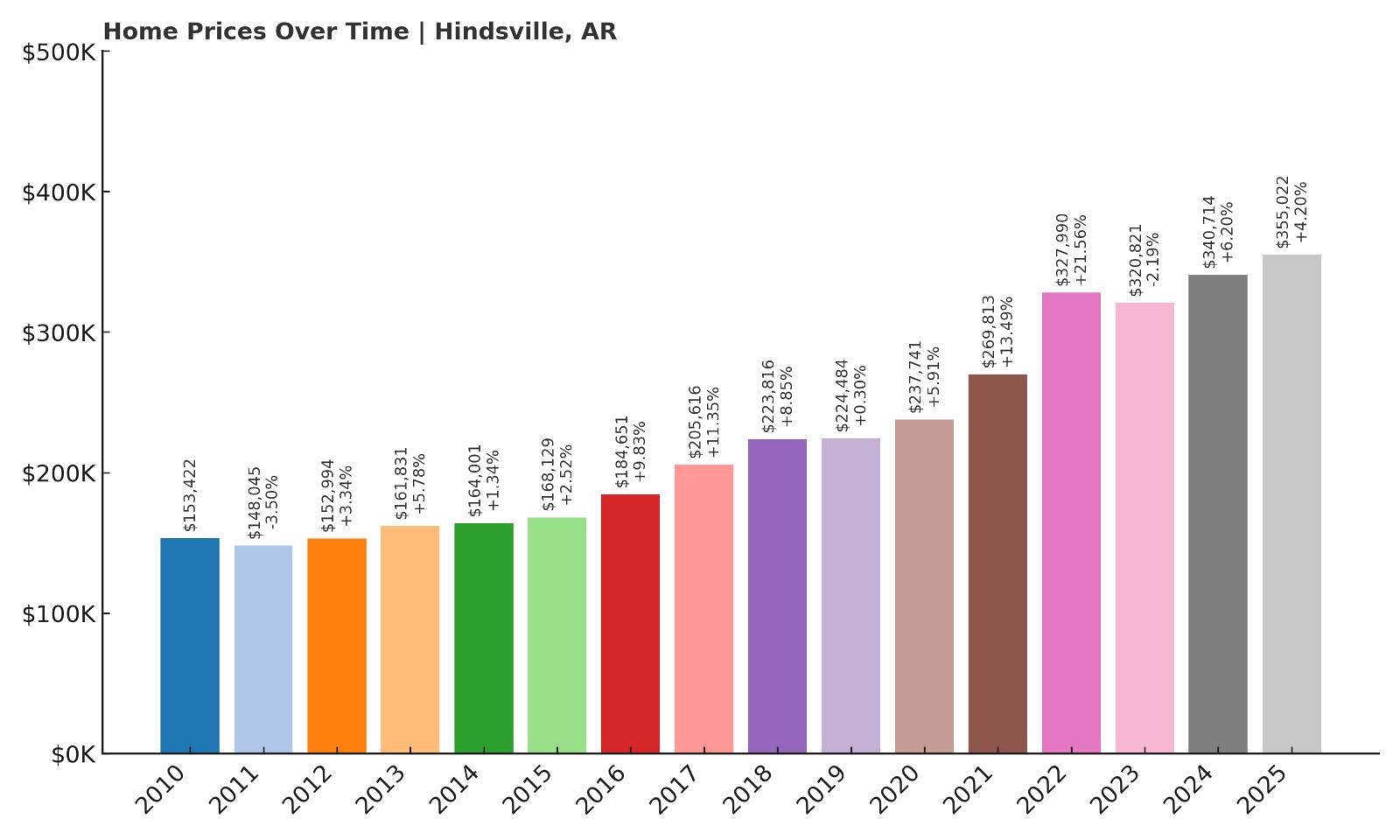
- 2010: $153,422.26
- 2011: $148,045.61 ($-5,376.65, -3.50% from previous year)
- 2012: $152,994.32 (+$4,948.71, +3.34% from previous year)
- 2013: $161,831.53 (+$8,837.21, +5.78% from previous year)
- 2014: $164,001.69 (+$2,170.16, +1.34% from previous year)
- 2015: $168,129.31 (+$4,127.62, +2.52% from previous year)
- 2016: $184,651.12 (+$16,521.81, +9.83% from previous year)
- 2017: $205,616.39 (+$20,965.27, +11.35% from previous year)
- 2018: $223,816.16 (+$18,199.77, +8.85% from previous year)
- 2019: $224,484.92 (+$668.76, +0.30% from previous year)
- 2020: $237,741.77 (+$13,256.85, +5.91% from previous year)
- 2021: $269,813.84 (+$32,072.07, +13.49% from previous year)
- 2022: $327,990.70 (+$58,176.86, +21.56% from previous year)
- 2023: $320,821.97 ($-7,168.73, -2.19% from previous year)
- 2024: $340,714.29 (+$19,892.32, +6.20% from previous year)
- 2025: $355,022.69 (+$14,308.40, +4.20% from previous year)
Hindsville’s home values have grown by over 131% since 2010, rising from $153,422 to $355,022 in 2025. The early growth was steady, but the market took off after 2020, with huge double-digit percentage gains recorded in 2021 and 2022. The following year saw a minor correction, but prices rebounded again in 2024 and continued climbing in 2025. This pattern suggests strong underlying demand and a healthy local market that adjusted briefly but kept pushing higher. For a small town in Madison County, Hindsville has outperformed many of its peers and now finds itself ranked among Arkansas’s most expensive communities.
Hindsville – A Rural Market With Surging Value
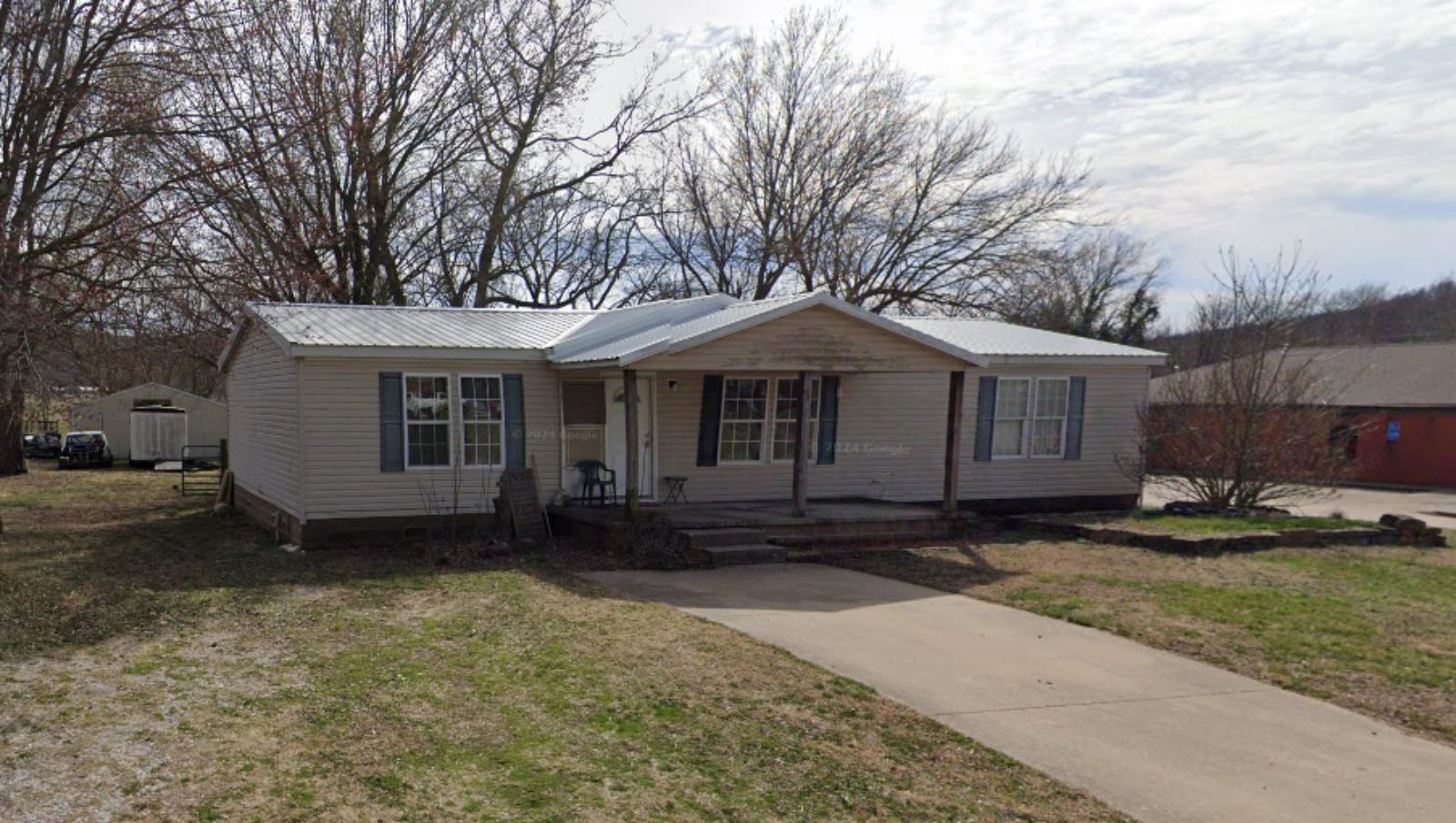
Hindsville is a small town tucked away in the hills of Madison County, surrounded by natural beauty and far removed from major highways or urban sprawl. What makes its real estate performance remarkable is that it’s largely driven by lifestyle demand. Buyers seeking peace, quiet, and proximity to outdoor recreation have increasingly turned to towns like Hindsville as an antidote to crowded city life. The town is located near Lake Hindsville and within easy driving distance of Huntsville and Fayetteville, giving residents access to basic amenities and job opportunities without sacrificing a rural setting. That balance has drawn retirees, remote workers, and people building custom homes on scenic land. Over the past decade, it’s quietly become one of the most valuable rural housing markets in the state.
The dramatic appreciation from 2020 to 2022 was likely driven by pandemic migration trends, as buyers flocked to areas with lower population density and greater space. Hindsville fits that bill perfectly and has the added benefit of being surrounded by national forest, rolling hills, and wildlife areas. Unlike in more suburban towns, much of the housing stock here is on larger parcels, giving buyers more land for their money—at least until recently. With average prices now above $355,000, Hindsville has joined the ranks of high-value markets, even without the dense infrastructure of larger cities. The appeal of country living with regional connectivity continues to push this market upward, suggesting strong long-term potential for those willing to live off the beaten path.
8. Fayetteville – 113.41% Home Price Increase Since 2010
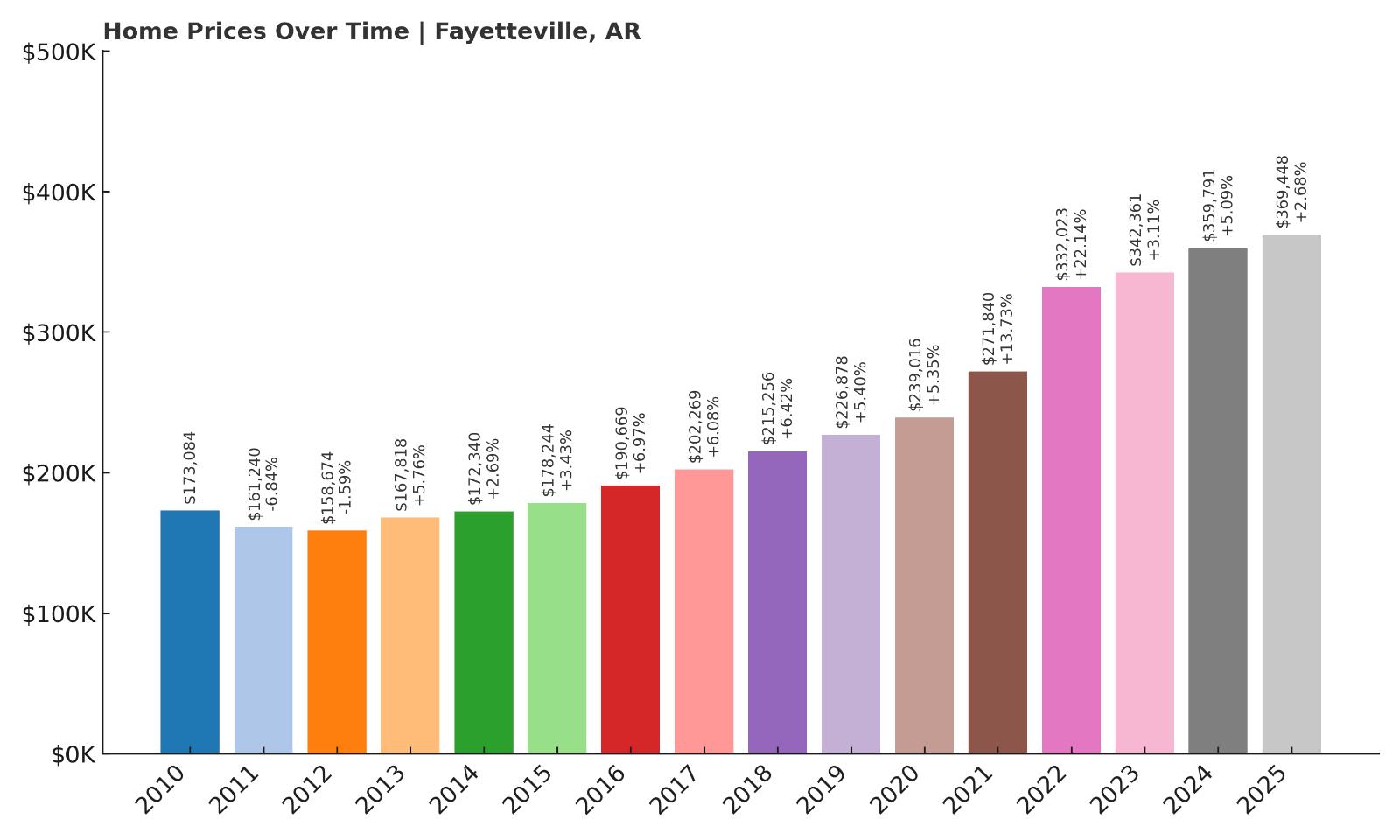
- 2010: $173,084.24
- 2011: $161,240.79 ($-11,843.45, -6.84% from previous year)
- 2012: $158,674.63 ($-2,566.16, -1.59% from previous year)
- 2013: $167,818.55 (+$9,143.92, +5.76% from previous year)
- 2014: $172,340.47 (+$4,521.92, +2.69% from previous year)
- 2015: $178,244.41 (+$5,903.94, +3.43% from previous year)
- 2016: $190,669.89 (+$12,425.48, +6.97% from previous year)
- 2017: $202,269.62 (+$11,599.73, +6.08% from previous year)
- 2018: $215,256.85 (+$12,987.23, +6.42% from previous year)
- 2019: $226,878.13 (+$11,621.28, +5.40% from previous year)
- 2020: $239,016.23 (+$12,138.10, +5.35% from previous year)
- 2021: $271,840.15 (+$32,823.92, +13.73% from previous year)
- 2022: $332,023.89 (+$60,183.74, +22.14% from previous year)
- 2023: $342,361.58 (+$10,337.69, +3.11% from previous year)
- 2024: $359,791.36 (+$17,429.78, +5.09% from previous year)
- 2025: $369,448.80 (+$9,657.44, +2.68% from previous year)
Fayetteville has seen prices climb from $173,084 in 2010 to $369,448 in 2025—a 113% increase over 15 years. While early growth was modest, post-2020 appreciation has been explosive. Prices surged in 2021 and 2022, and though the pace has slowed since, values continue to rise. With a large student population, a growing tech presence, and an increasingly vibrant downtown, Fayetteville remains one of Arkansas’s most dynamic housing markets. The growth here is no surprise—but the consistency and magnitude of appreciation have pushed it into the top 10 statewide in terms of home value.
Fayetteville – Culture, Education, and Sustained Demand
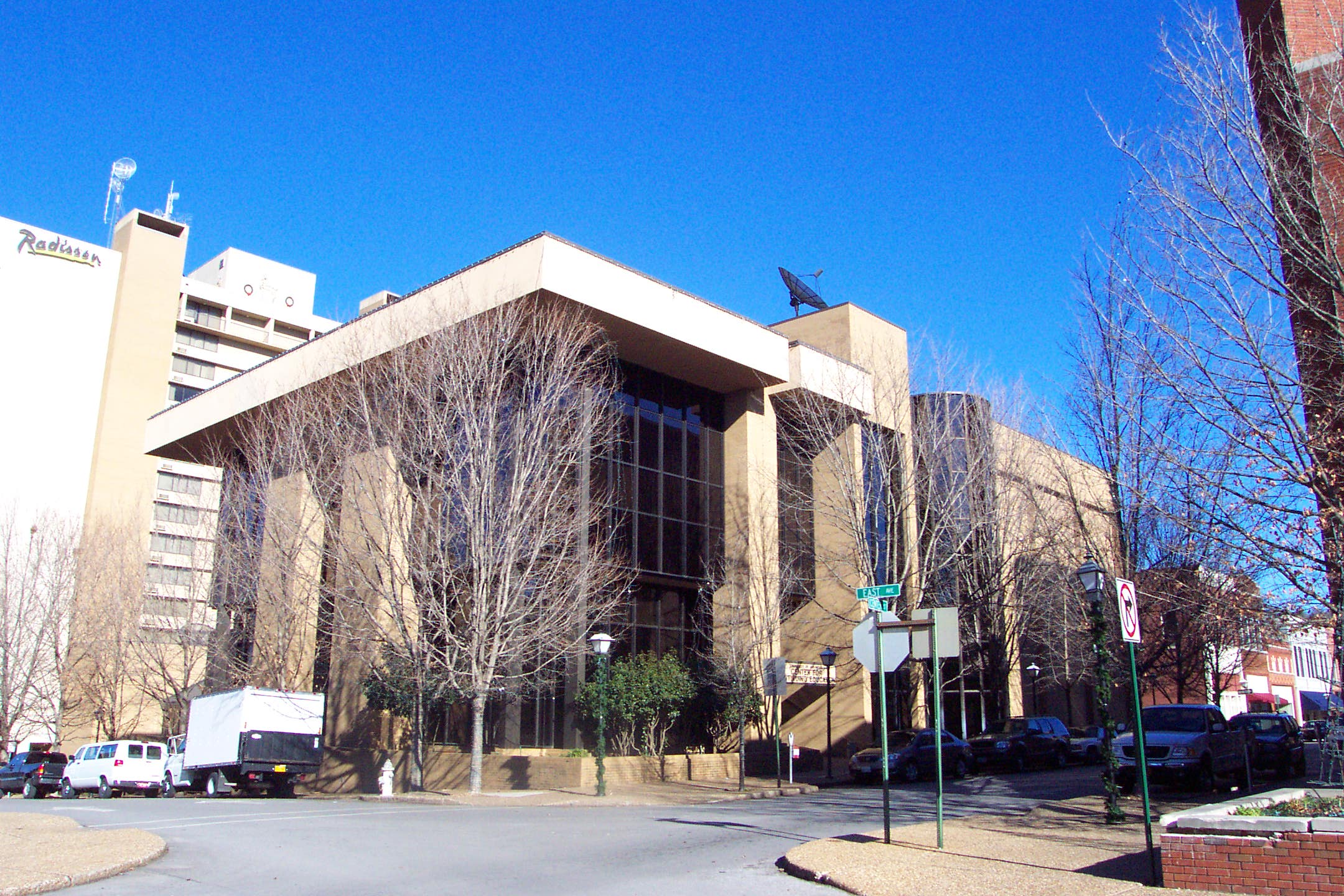
As the home of the University of Arkansas, Fayetteville has long held a unique place in the state’s housing landscape. The city combines the energy of a college town with the resources of a regional economic center. Over the past decade, the university’s expansion has fueled not only enrollment but also private development, including new apartments, retail centers, and higher-end homes. Fayetteville’s historic neighborhoods remain highly sought after, while the city’s west side continues to see new construction aimed at families and professionals. The presence of cultural institutions, a walkable downtown, and a strong food and music scene all contribute to a high quality of life that continues to draw new residents from across the region—and beyond.
Fayetteville’s real estate market benefits from both local and out-of-state demand. Young professionals relocating for jobs, students staying after graduation, and investors seeking rental income all help keep pressure on inventory. While new construction has tried to keep pace, the city’s hilly terrain and zoning constraints have limited expansion in some areas. That’s contributed to rising values, especially since 2020, when remote work and lifestyle shifts led to more interest in vibrant mid-sized cities. With average home values nearing $370,000, Fayetteville is no longer just a college town—it’s a year-round destination with staying power, backed by job growth, education, and amenities that support long-term demand.
7. Rogers – 156.12% Home Price Increase Since 2010
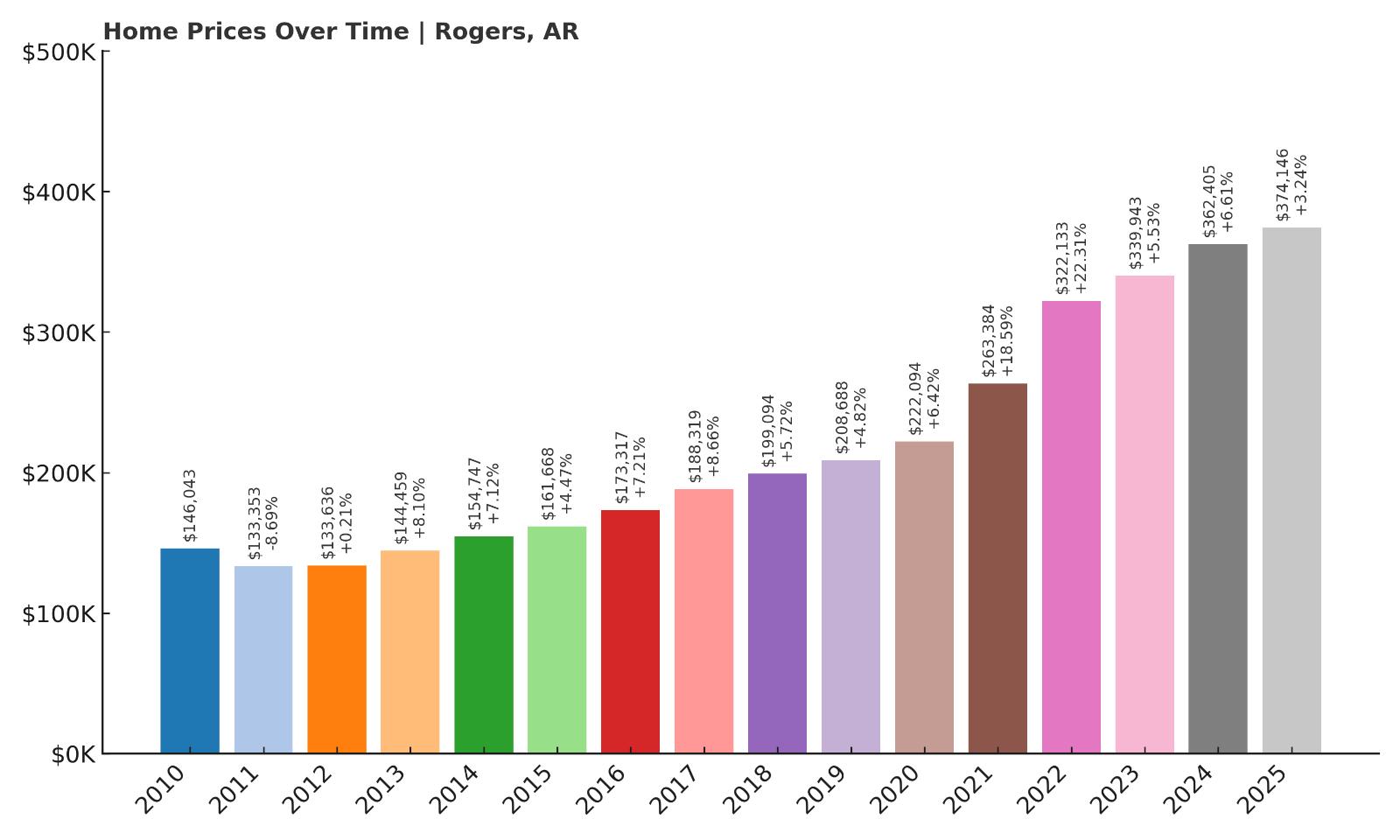
- 2010: $146,043.93
- 2011: $133,353.30 ($-12,690.63, -8.69% from previous year)
- 2012: $133,636.95 (+$283.65, +0.21% from previous year)
- 2013: $144,459.46 (+$10,822.51, +8.10% from previous year)
- 2014: $154,747.88 (+$10,288.42, +7.12% from previous year)
- 2015: $161,668.14 (+$6,920.26, +4.47% from previous year)
- 2016: $173,317.03 (+$11,648.89, +7.21% from previous year)
- 2017: $188,319.88 (+$15,002.85, +8.66% from previous year)
- 2018: $199,094.04 (+$10,774.16, +5.72% from previous year)
- 2019: $208,688.95 (+$9,594.91, +4.82% from previous year)
- 2020: $222,094.61 (+$13,405.66, +6.42% from previous year)
- 2021: $263,384.27 (+$41,289.66, +18.59% from previous year)
- 2022: $322,133.86 (+$58,749.59, +22.31% from previous year)
- 2023: $339,943.29 (+$17,809.43, +5.53% from previous year)
- 2024: $362,405.07 (+$22,461.78, +6.61% from previous year)
- 2025: $374,146.92 (+$11,741.85, +3.24% from previous year)
Rogers’ housing market has climbed more than 156% since 2010, with home values rising from $146,000 to over $374,000 in 2025. While prices dipped in the early years, growth accelerated steadily throughout the 2010s, culminating in two explosive jumps in 2021 and 2022. Combined, those two years alone added more than $100,000 in value. Though the pace of growth has slowed somewhat since, the upward trend continues. Rogers’ mix of economic vitality, retail development, and strong livability metrics have made it one of Arkansas’s most consistently desirable—and increasingly expensive—housing markets.
Rogers – Northwest Arkansas’s Retail and Residential Anchor
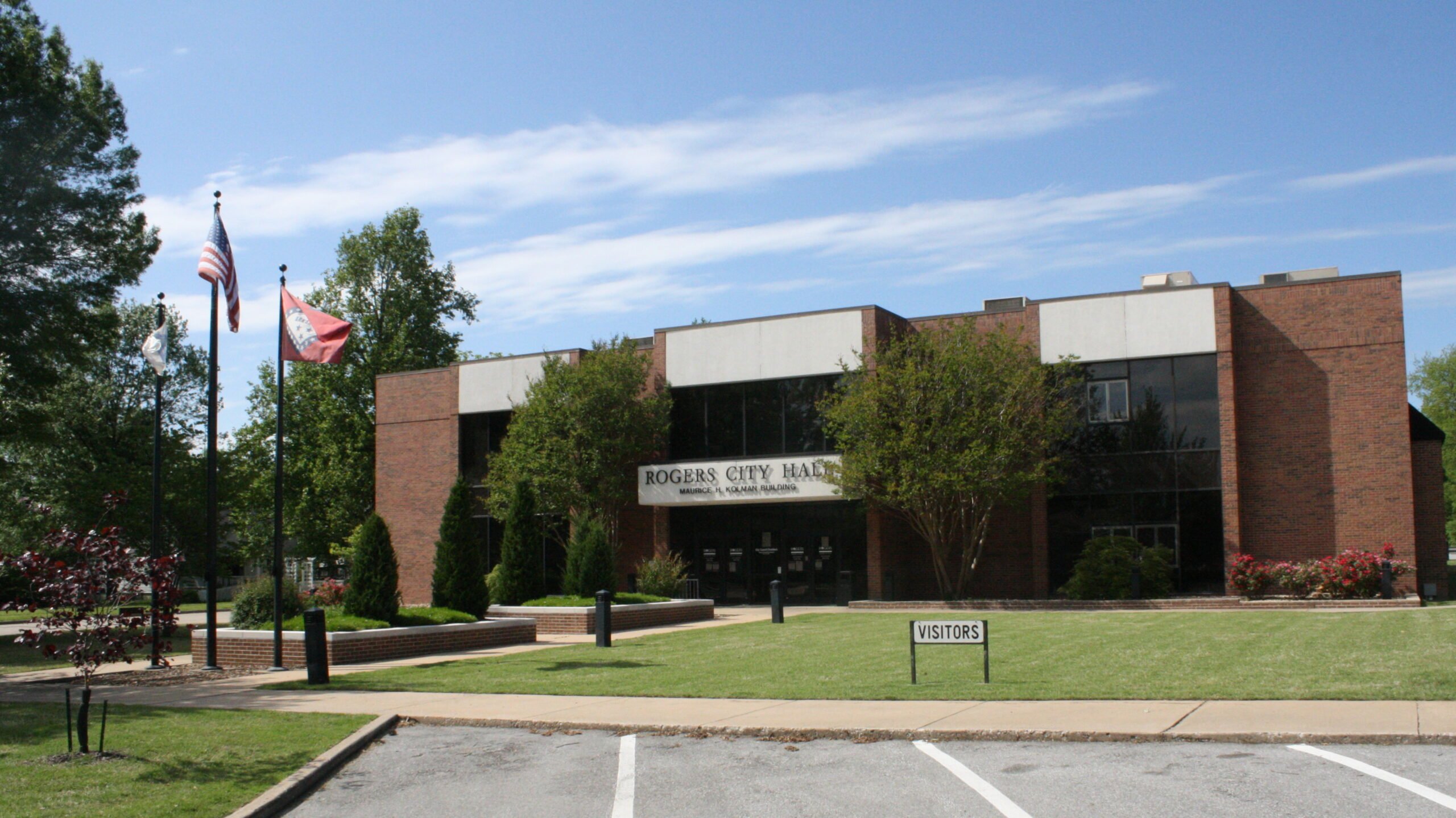
Located in the heart of Benton County, Rogers is one of the pillars of Northwest Arkansas’s economic and residential boom. With a population nearing 75,000, it balances suburban livability with big-city convenience. The Pinnacle Hills area is a prime example: a bustling zone packed with shopping, restaurants, high-end apartments, and medical centers. This modern commercial corridor has played a huge role in reshaping Rogers’ image from a quiet suburban city to a vibrant economic hub. Add to that several top-rated schools, abundant parks, and cultural institutions like the Walmart AMP amphitheater, and it’s no wonder Rogers has become a magnet for families, professionals, and retirees alike.
The town’s real estate strength comes not only from its amenities but also its strategic position. Rogers is situated between Bentonville to the north and Springdale to the south, putting residents within a short drive of major employers and regional attractions. This location, coupled with years of sustained infrastructure investment, has allowed for continuous residential development across the city. Many of the homes built in the last 15 years are in thoughtfully planned communities, offering both value and appreciation potential. Even as prices push toward $375,000, demand remains high. Rogers has proven itself as a long-term real estate winner—blending location, livability, and lifestyle into one of Arkansas’s top-tier markets.
6. Garfield – 182.95% Home Price Increase Since 2010
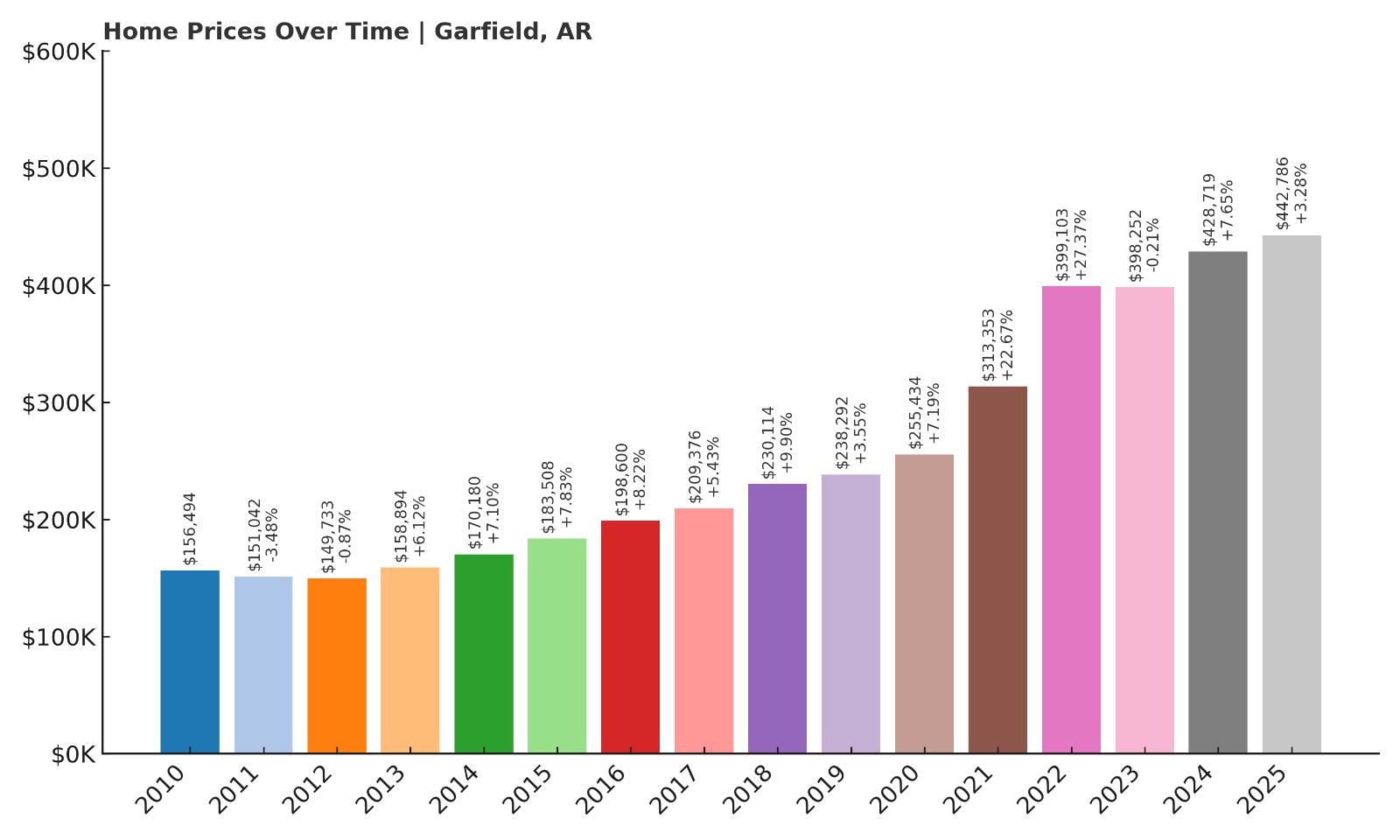
- 2010: $156,494.91
- 2011: $151,042.43 ($-5,452.48, -3.48% from previous year)
- 2012: $149,733.54 ($-1,308.89, -0.87% from previous year)
- 2013: $158,894.96 (+$9,161.42, +6.12% from previous year)
- 2014: $170,180.87 (+$11,285.91, +7.10% from previous year)
- 2015: $183,508.96 (+$13,328.09, +7.83% from previous year)
- 2016: $198,600.55 (+$15,091.59, +8.22% from previous year)
- 2017: $209,376.96 (+$10,776.41, +5.43% from previous year)
- 2018: $230,114.12 (+$20,737.16, +9.90% from previous year)
- 2019: $238,292.78 (+$8,178.66, +3.55% from previous year)
- 2020: $255,434.30 (+$17,141.52, +7.19% from previous year)
- 2021: $313,353.24 (+$57,918.94, +22.67% from previous year)
- 2022: $399,103.50 (+$85,750.26, +27.37% from previous year)
- 2023: $398,252.28 ($-851.22, -0.21% from previous year)
- 2024: $428,719.07 (+$30,466.79, +7.65% from previous year)
- 2025: $442,786.41 (+$14,067.34, +3.28% from previous year)
Garfield’s housing market has more than doubled over the past 15 years, with values climbing 183% from $156,495 in 2010 to $442,786 in 2025. The market showed steady growth for most of the 2010s, followed by two huge leaps in 2021 and 2022. Those years alone brought nearly $145,000 in additional value. While prices briefly plateaued in 2023, growth resumed again in 2024 and 2025. The numbers reflect Garfield’s emergence as one of Arkansas’s highest-value rural markets—a place where natural beauty, space, and regional proximity have combined to push demand, and prices, to new heights.
Garfield – Elevated Living on the Shores of Beaver Lake

Garfield sits in northeastern Benton County, perched above the northern reaches of Beaver Lake. Its scenic location and large residential lots have made it especially attractive to buyers looking for privacy, views, and space—all within driving distance of Bentonville. While the town itself remains unincorporated and lightly developed, it has benefited from spillover demand as Northwest Arkansas continues its expansion. Garfield has emerged as a favorite among lakefront buyers, custom home builders, and anyone seeking natural surroundings without sacrificing access to jobs and services. What began as a hidden retreat has become a high-end haven, with many properties now rivaling or exceeding those in urban cores.
The lake is Garfield’s greatest draw, but it’s not the only one. The surrounding Ozark terrain, access to outdoor recreation, and availability of large land parcels have made it a magnet for second-home buyers and remote workers. Much of the town’s inventory consists of custom builds and newer homes with expansive lots—features that drive higher values. As homebuyers increasingly prioritize lifestyle and location over square footage alone, Garfield continues to outperform expectations. With values now pushing past $440,000 and limited new supply coming online, its real estate market appears poised to remain competitive. For those seeking Arkansas’s rare blend of luxury and nature, Garfield is setting a new standard.
5. Bentonville – 164.94% Home Price Increase Since 2010
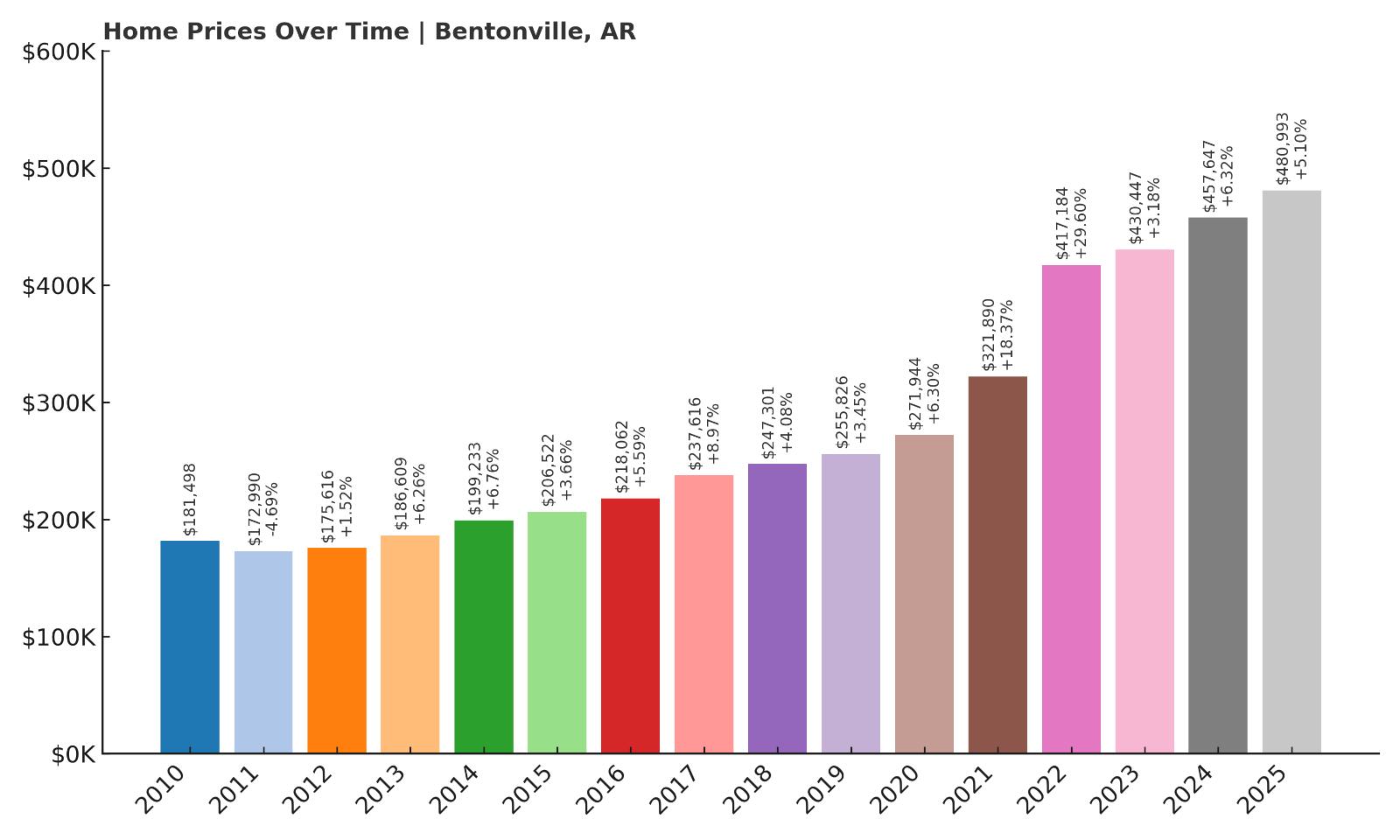
- 2010: $181,498.30
- 2011: $172,990.12 ($-8,508.18, -4.69% from previous year)
- 2012: $175,616.01 (+$2,625.89, +1.52% from previous year)
- 2013: $186,609.32 (+$10,993.31, +6.26% from previous year)
- 2014: $199,233.22 (+$12,623.90, +6.76% from previous year)
- 2015: $206,522.00 (+$7,288.78, +3.66% from previous year)
- 2016: $218,062.39 (+$11,540.39, +5.59% from previous year)
- 2017: $237,616.92 (+$19,554.53, +8.97% from previous year)
- 2018: $247,301.38 (+$9,684.46, +4.08% from previous year)
- 2019: $255,826.49 (+$8,525.11, +3.45% from previous year)
- 2020: $271,944.10 (+$16,117.61, +6.30% from previous year)
- 2021: $321,890.48 (+$49,946.38, +18.37% from previous year)
- 2022: $417,184.89 (+$95,294.41, +29.60% from previous year)
- 2023: $430,447.61 (+$13,262.72, +3.18% from previous year)
- 2024: $457,647.05 (+$27,199.44, +6.32% from previous year)
- 2025: $480,993.45 (+$23,346.40, +5.10% from previous year)
Bentonville has experienced a dramatic 165% increase in home values since 2010, with the average price rising from $181,498 to nearly $481,000 in 2025. This steady climb accelerated sharply after 2020, with back-to-back record-breaking increases in 2021 and 2022 adding over $145,000 in just two years. Since then, growth has remained strong but more controlled. Bentonville’s rapid appreciation reflects not just local demand, but its emergence as one of the fastest-growing economic hubs in the central U.S., powered largely by the influence of Walmart and the city’s investment in livability and infrastructure.
Bentonville – Corporate Capital Turned Cultural Center
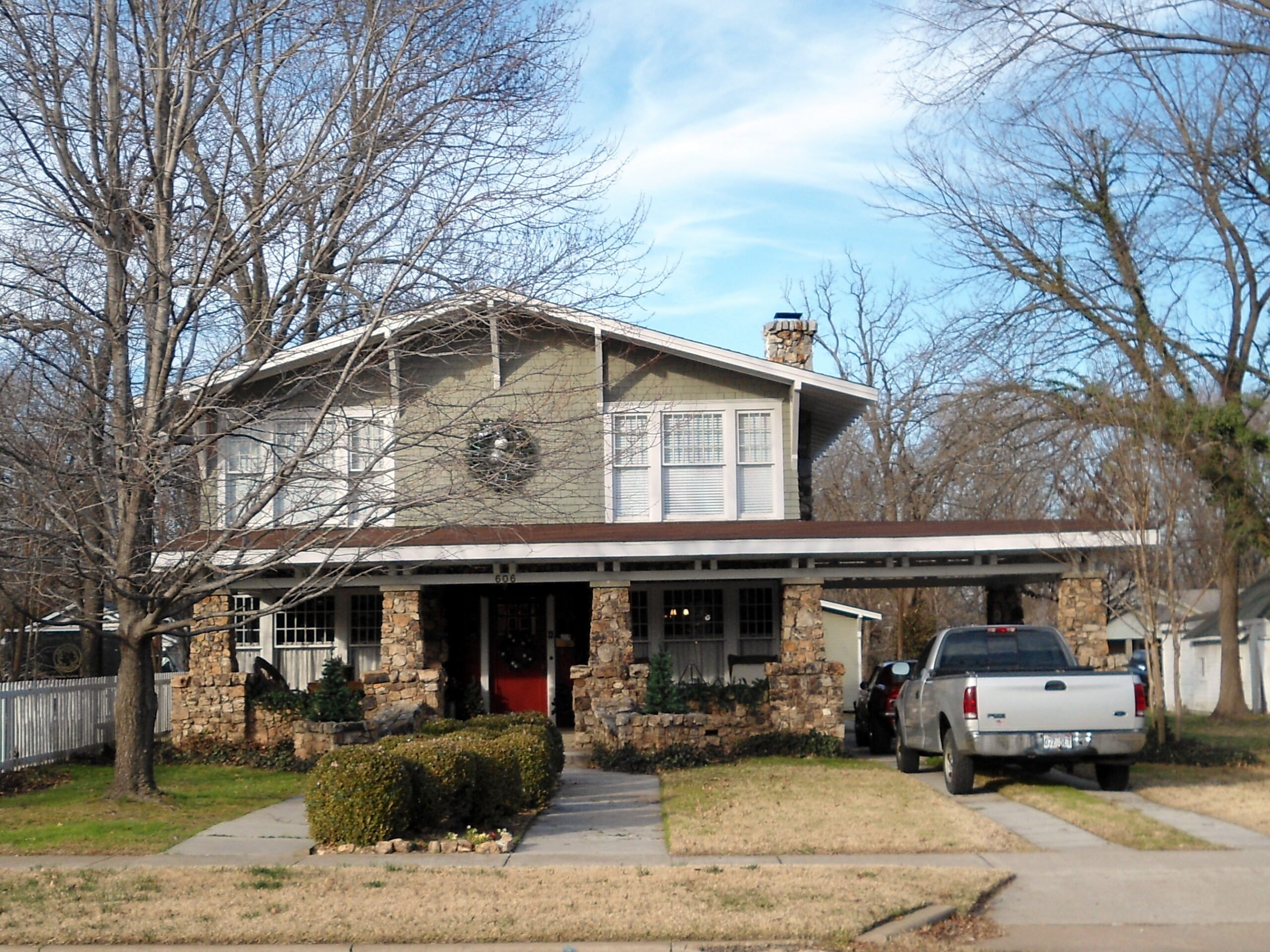
Home to Walmart’s global headquarters, Bentonville has long held economic importance—but over the past decade, it has transformed into a dynamic and livable city in its own right. Fueled by a booming job market, strategic investments in arts and public space, and aggressive urban development, the city now ranks among the most desirable places to live in the entire region. Crystal Bridges Museum of American Art, the Momentary, and a series of downtown revitalization projects have helped recast Bentonville’s image from a corporate town to a cultural hub. That, combined with a rapidly expanding population of white-collar professionals, has pushed housing demand sky-high.
Residential construction has attempted to keep up, but soaring demand for walkable neighborhoods and proximity to Bentonville’s growing downtown has driven up prices across the board. The city’s western and northern edges have seen rapid development, yet older neighborhoods closer to downtown command premium values due to limited inventory. Many buyers relocating from larger cities are willing to pay top dollar for Bentonville’s mix of economic opportunity and lifestyle perks. As Northwest Arkansas continues to draw national attention, Bentonville sits at the center of it all—now not just as a corporate headquarters, but as a lifestyle brand in its own right.
4. Little Flock – 170.60% Home Price Increase Since 2010
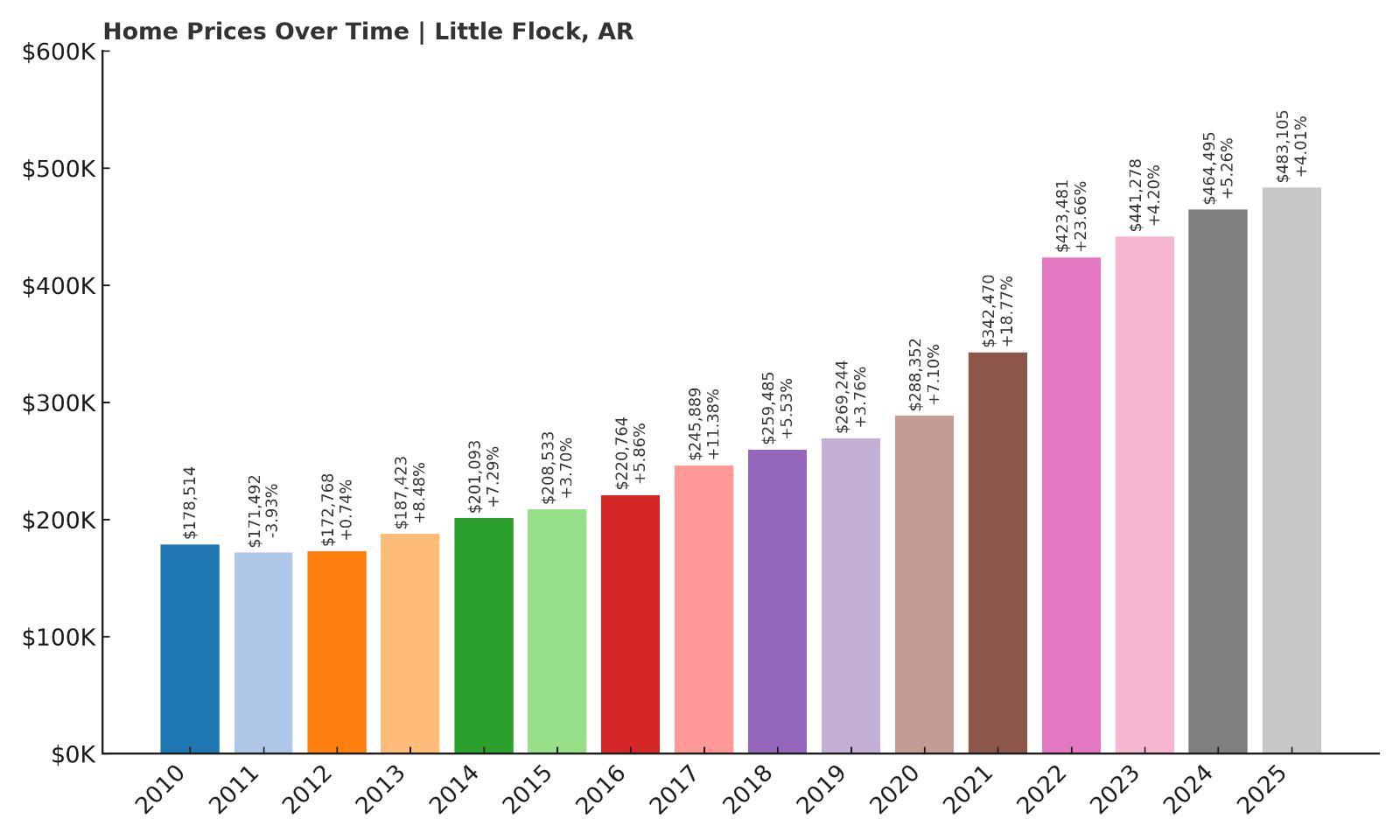
- 2010: $178,514.08
- 2011: $171,492.51 ($-7,021.57, -3.93% from previous year)
- 2012: $172,768.49 (+$1,275.98, +0.74% from previous year)
- 2013: $187,423.74 (+$14,655.25, +8.48% from previous year)
- 2014: $201,093.21 (+$13,669.47, +7.29% from previous year)
- 2015: $208,533.98 (+$7,440.77, +3.70% from previous year)
- 2016: $220,764.22 (+$12,230.24, +5.86% from previous year)
- 2017: $245,889.04 (+$25,124.82, +11.38% from previous year)
- 2018: $259,485.72 (+$13,596.68, +5.53% from previous year)
- 2019: $269,244.04 (+$9,758.32, +3.76% from previous year)
- 2020: $288,352.21 (+$19,108.17, +7.10% from previous year)
- 2021: $342,470.07 (+$54,117.86, +18.77% from previous year)
- 2022: $423,481.71 (+$81,011.64, +23.66% from previous year)
- 2023: $441,278.31 (+$17,796.60, +4.20% from previous year)
- 2024: $464,495.28 (+$23,216.97, +5.26% from previous year)
- 2025: $483,105.17 (+$18,609.89, +4.01% from previous year)
Little Flock has posted an impressive 170.6% increase in home values since 2010, climbing from $178,514 to over $483,000 in 2025. Though smaller and less well-known than its neighbors, this Benton County town has seen extraordinary demand, especially in the post-2020 era. A combination of affordability, location, and scenic setting has made it one of the region’s breakout markets. Annual gains of 18–23% during the 2021–2022 boom elevated it quickly into the top tier of Arkansas housing, and steady appreciation continues today.
Little Flock – Secluded Hills, Big Home Prices
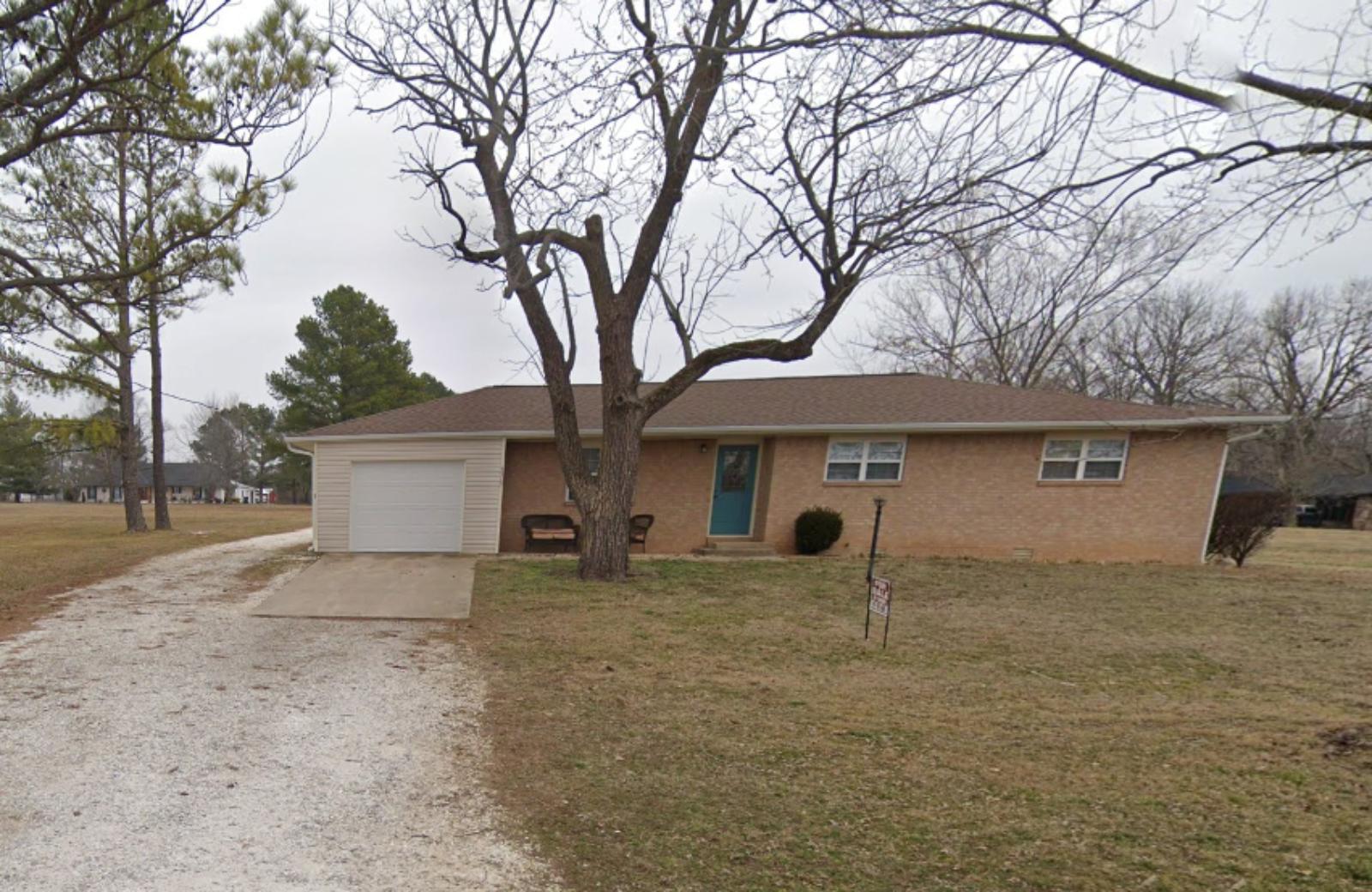
Little Flock is a quiet, largely residential town nestled in the hills just northeast of Rogers. For years, it remained under the radar—overshadowed by Bentonville and Rogers. But its low-density development, mature tree cover, and rolling topography have made it increasingly appealing to buyers seeking space and serenity within minutes of urban convenience. Many of its homes sit on larger lots or wooded parcels, and the lack of heavy commercial development has preserved its quiet, almost rural character. That contrast—urban proximity with country feel—has made it one of the most desirable enclaves in the area, especially among higher-income buyers seeking a retreat without a long commute.
As demand across Northwest Arkansas intensified, Little Flock offered a rare balance: relative affordability (at least initially), scenic charm, and excellent location. That balance didn’t last long. Once home to modest subdivisions and older ranch-style homes, the town is now seeing more custom builds and luxury-style developments. With Beaver Lake access nearby and key shopping hubs just a few minutes away, Little Flock now boasts prices that rival or exceed larger neighboring cities. For buyers, it’s no longer a hidden option—it’s a premium one. And with average values now over $480,000 and rising, it’s firmly secured its position among Arkansas’s most expensive markets.
3. Cave Springs – 196.57% Home Price Increase Since 2010
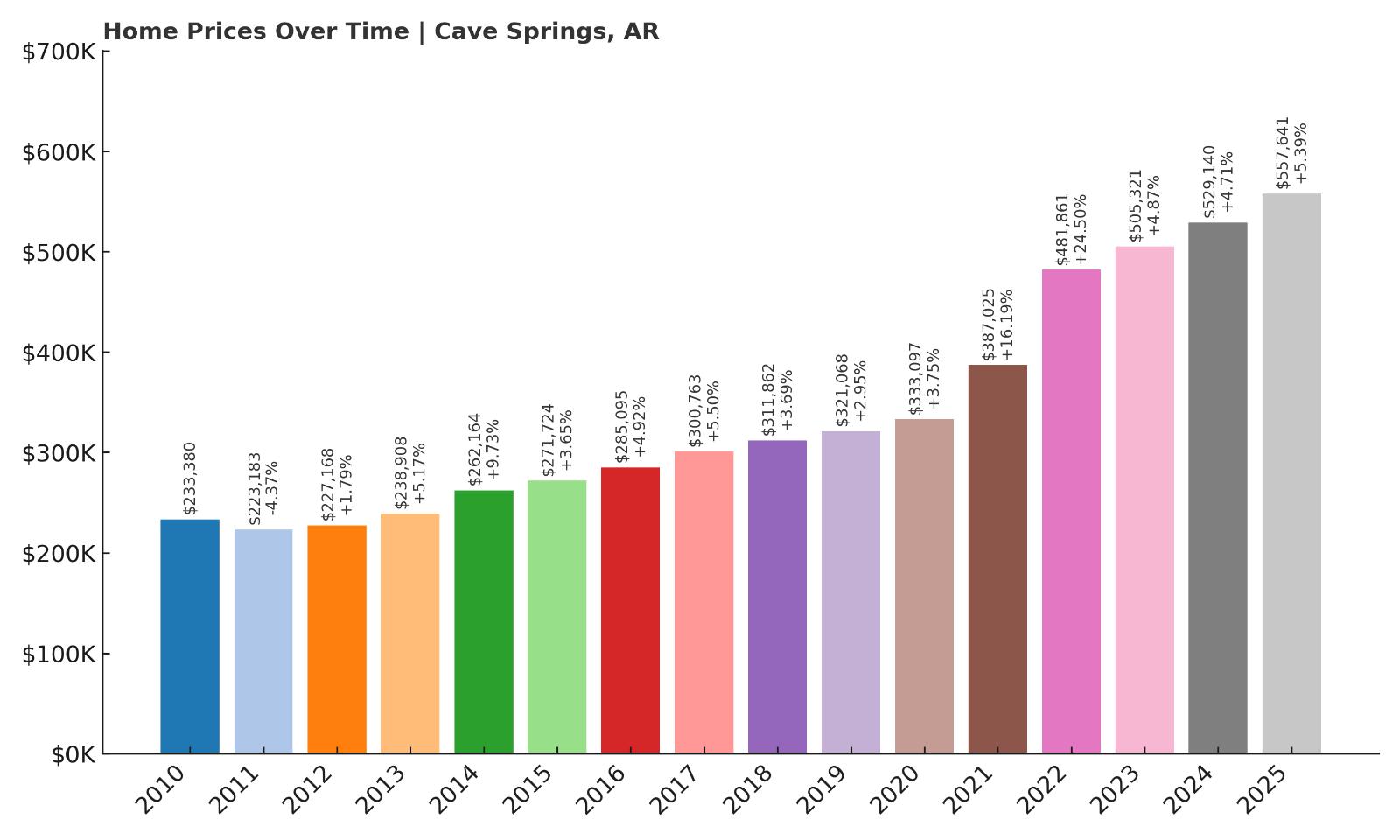
- 2010: $192,476.80
- 2011: $187,150.30 ($-5,326.50, -2.77% from previous year)
- 2012: $192,757.23 (+$5,606.93, +2.99% from previous year)
- 2013: $206,033.23 (+$13,276.00, +6.89% from previous year)
- 2014: $226,795.91 (+$20,762.68, +10.08% from previous year)
- 2015: $237,936.87 (+$11,140.96, +4.91% from previous year)
- 2016: $260,444.52 (+$22,507.65, +9.46% from previous year)
- 2017: $287,257.11 (+$26,812.59, +10.29% from previous year)
- 2018: $306,933.13 (+$19,676.02, +6.85% from previous year)
- 2019: $318,654.78 (+$11,721.65, +3.82% from previous year)
- 2020: $337,283.04 (+$18,628.26, +5.85% from previous year)
- 2021: $408,248.67 (+$70,965.63, +21.04% from previous year)
- 2022: $518,374.46 (+$110,125.79, +26.97% from previous year)
- 2023: $536,768.49 (+$18,394.03, +3.55% from previous year)
- 2024: $571,137.27 (+$34,368.78, +6.40% from previous year)
- 2025: $571,289.58 (+$152.31, +0.03% from previous year)
In just 15 years, Cave Springs has seen home prices surge by nearly 197%, climbing from under $193,000 in 2010 to over $571,000 in 2025. The growth has been especially intense since 2020, including a staggering $110,000 jump in 2022 alone. Though 2025 saw prices level off, the long-term rise cements Cave Springs as one of Arkansas’s premier high-value housing markets. Located in the booming Northwest Arkansas corridor, the town has become synonymous with luxury living, new construction, and high demand from upwardly mobile buyers.
Cave Springs – Custom Homes, High Elevation, and Skyrocketing Prices
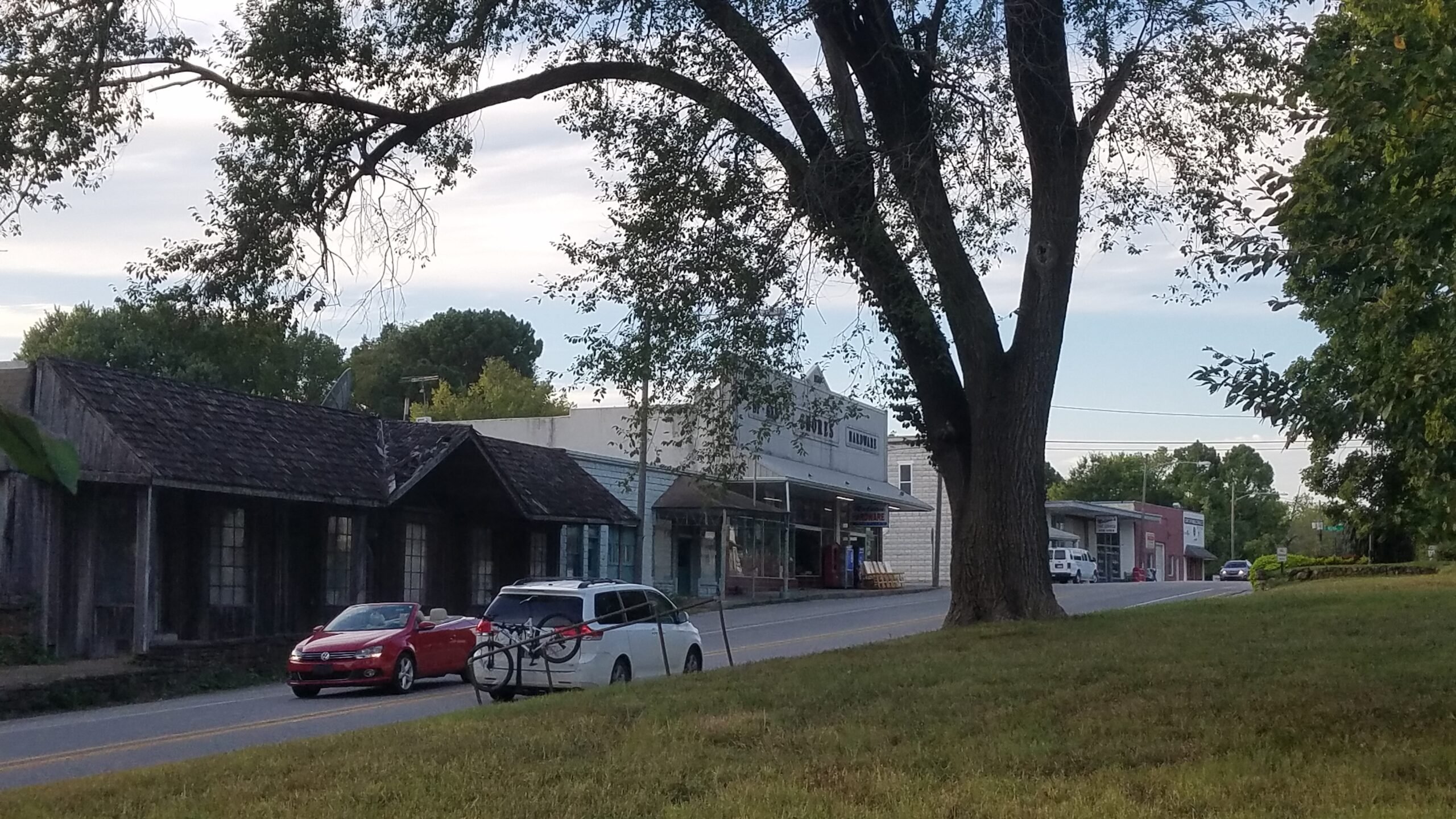
One of the crown jewels of Benton County, Cave Springs has evolved into a high-end bedroom community for professionals working in Bentonville, Rogers, and beyond. Its appeal starts with its topography—rolling hills, high ridges, and views of the Ozarks distinguish it from more densely built urban cores. That elevation, along with careful zoning and master-planned developments, has helped attract premium buyers and builders. Many new homes in the area feature upscale finishes, oversized lots, and custom design—pushing average values higher year after year. The result is a town that now consistently ranks among the most expensive in Arkansas, with a reputation for quality, privacy, and exclusivity.
Cave Springs also benefits from strong schools, proximity to job centers, and a growing roster of high-income residents. What was once a sleepy, low-density area has quickly transitioned into a luxury housing hotspot. Buyers priced out of Bentonville and Rogers increasingly look here for space and quiet without giving up convenience. Though prices have cooled slightly after several explosive years, the fundamentals remain strong. With limited space for expansion and sustained demand from affluent newcomers, Cave Springs is likely to stay at or near the top of Arkansas’s price rankings for years to come.
2. Elm Springs – 229.61% Home Price Increase Since 2010
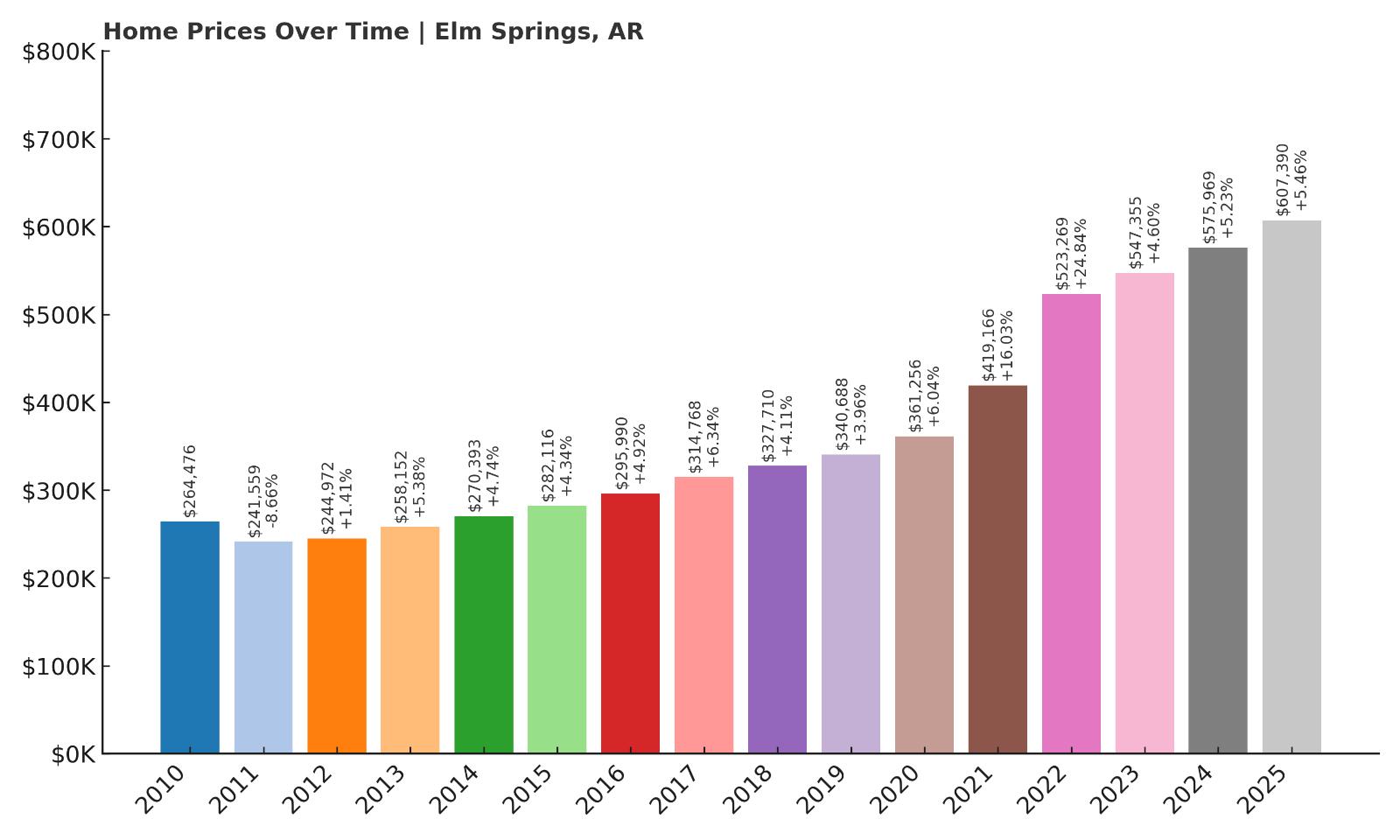
- 2010: $177,520.90
- 2011: $160,661.32 ($-16,859.58, -9.50% from previous year)
- 2012: $166,893.66 (+$6,232.34, +3.88% from previous year)
- 2013: $182,888.42 (+$15,994.76, +9.58% from previous year)
- 2014: $195,426.85 (+$12,538.43, +6.85% from previous year)
- 2015: $209,752.94 (+$14,326.09, +7.33% from previous year)
- 2016: $231,820.34 (+$22,067.40, +10.52% from previous year)
- 2017: $248,564.68 (+$16,744.34, +7.22% from previous year)
- 2018: $263,587.95 (+$15,023.27, +6.04% from previous year)
- 2019: $274,017.41 (+$10,429.46, +3.96% from previous year)
- 2020: $291,201.43 (+$17,184.02, +6.27% from previous year)
- 2021: $368,342.59 (+$77,141.16, +26.50% from previous year)
- 2022: $482,120.33 (+$113,777.74, +30.89% from previous year)
- 2023: $491,972.70 (+$9,852.37, +2.04% from previous year)
- 2024: $515,868.14 (+$23,895.44, +4.86% from previous year)
- 2025: $585,174.67 (+$69,306.53, +13.43% from previous year)
Elm Springs has seen home values climb a staggering 230% since 2010, rising from just $177,521 to over $585,000 in 2025. After steady growth during the 2010s, the market exploded in the early 2020s with consecutive double-digit increases. Values spiked again in 2025, adding nearly $70,000 in just one year. Located near the intersection of Washington and Benton counties, Elm Springs has quietly become one of the most desirable (and most expensive) towns in the state—thanks to a rare mix of location, space, and community feel.
Elm Springs – The Price of Privacy in a Central Location
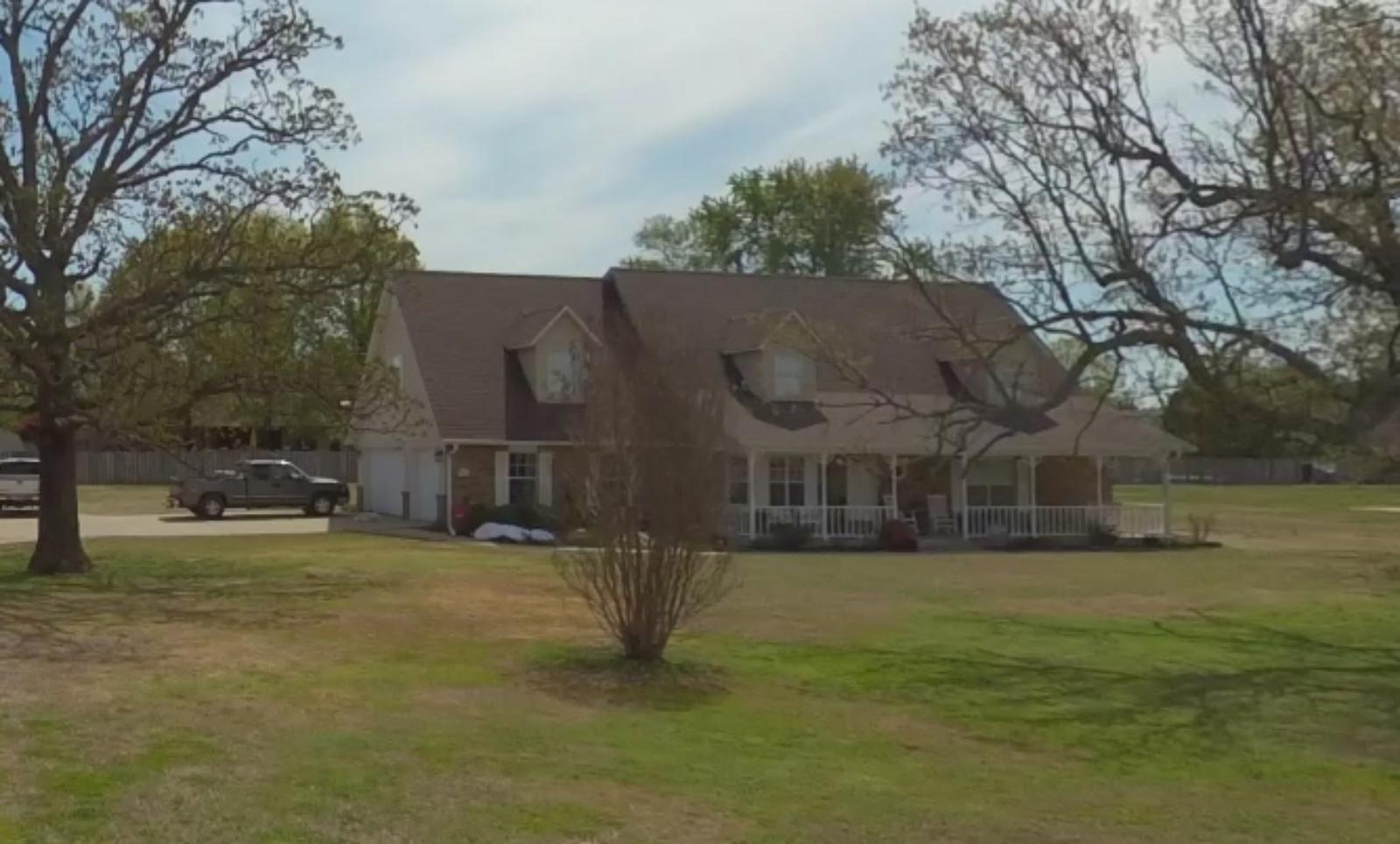
Elm Springs is one of Northwest Arkansas’s best-kept real estate secrets—though that label may not hold much longer. Nestled between Springdale, Tontitown, and Lowell, it offers a prime location without the congestion of nearby cities. Historically a rural farming area, it has seen a major transformation as demand for quiet, upscale residential areas has intensified. Large homes, oversized lots, and custom development characterize much of its recent construction. Unlike denser parts of Springdale, Elm Springs feels open and expansive—an attractive quality for buyers looking to trade city buzz for tranquil living. That unique offering has fueled demand and helped push prices past the half-million mark in recent years.
Elm Springs doesn’t offer the same level of commercial development as its neighbors, but that’s part of the appeal. Residents here often choose it precisely for the slower pace, cleaner design, and residential focus. And with easy access to both I-49 and major employers, it’s well-positioned for commuters. As new residents continue to move into Northwest Arkansas, Elm Springs is increasingly viewed as a premium choice for those who want it all—privacy, space, location, and appreciation potential. Based on current trajectories, it’s no surprise this small town has soared into the #2 spot statewide for home values.
1. Goshen – 255.40% Home Price Increase Since 2010
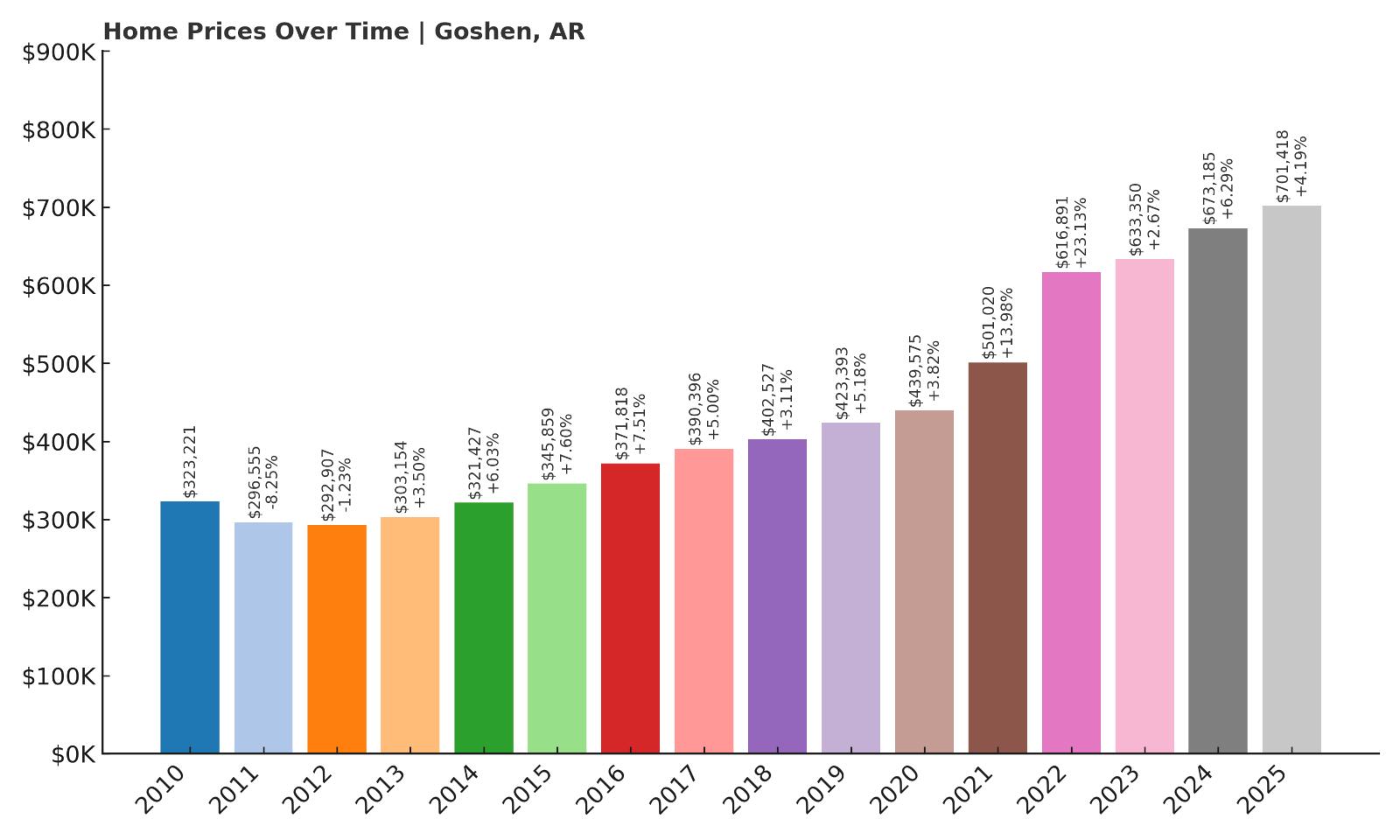
- 2010: $170,980.20
- 2011: $168,206.69 ($-2,773.51, -1.62% from previous year)
- 2012: $179,190.80 (+$10,984.11, +6.53% from previous year)
- 2013: $192,384.94 (+$13,194.14, +7.36% from previous year)
- 2014: $209,303.06 (+$16,918.12, +8.79% from previous year)
- 2015: $214,065.38 (+$4,762.32, +2.28% from previous year)
- 2016: $224,054.56 (+$9,989.18, +4.67% from previous year)
- 2017: $244,521.80 (+$20,467.24, +9.13% from previous year)
- 2018: $264,493.47 (+$19,971.67, +8.17% from previous year)
- 2019: $276,182.66 (+$11,689.19, +4.42% from previous year)
- 2020: $294,483.21 (+$18,300.55, +6.63% from previous year)
- 2021: $367,607.71 (+$73,124.50, +24.83% from previous year)
- 2022: $478,255.91 (+$110,648.20, +30.11% from previous year)
- 2023: $493,497.40 (+$15,241.49, +3.19% from previous year)
- 2024: $542,839.69 (+$49,342.29, +10.00% from previous year)
- 2025: $606,758.59 (+$63,918.90, +11.78% from previous year)
Goshen tops the list with a 255.4% increase in home prices since 2010—far outpacing every other town in Arkansas. Home values here climbed from just under $171,000 to over $606,000 in 2025. While prices grew steadily throughout the 2010s, the real explosion came post-2020. Three massive surges in 2021, 2022, and 2025 added nearly $250,000 in value. With its combination of scenic location and limited inventory, Goshen has emerged as the most expensive housing market in the state.
Goshen – Arkansas’s Most Exclusive Market
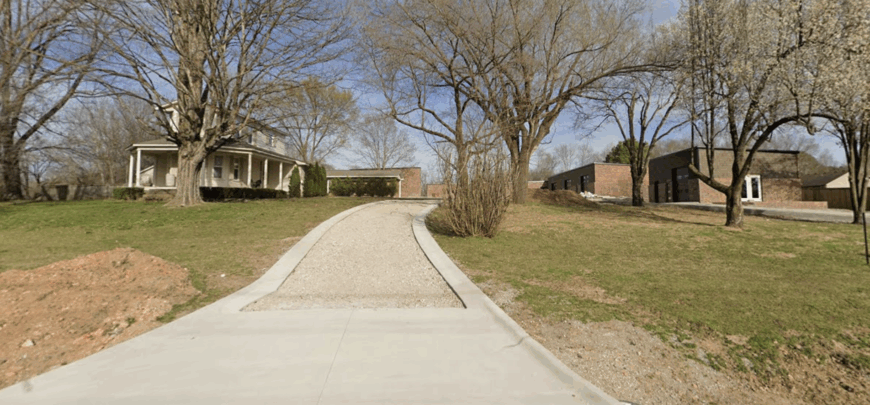
Located just east of Fayetteville, Goshen has quickly become Northwest Arkansas’s premier high-end residential destination. It’s known for sprawling estates, winding rural roads, and proximity to the White River. Many homes sit on multi-acre lots and feature custom architecture, gated entries, and scenic views. Despite its rural character, Goshen is only a short drive from the University of Arkansas and major regional employers—making it uniquely positioned for affluent professionals and retirees. With limited zoning for dense development, demand has far outpaced supply, and prices have soared accordingly.
Unlike many towns on this list, Goshen hasn’t seen massive commercial buildout or large-scale subdivisions. Its growth has come from targeted development—mostly custom builds and estate homes on premium land. This controlled growth, combined with its natural beauty, has attracted a specific kind of buyer: one seeking luxury, space, and tranquility without straying too far from the urban core. In 2025, its average home value passed $600,000, a symbolic threshold that reflects its elite status in Arkansas real estate. For those who can afford it, Goshen offers unmatched privacy and prestige—and as trends continue, it shows no signs of slowing down.



